Pass cursor over name for more information
Adam & Eve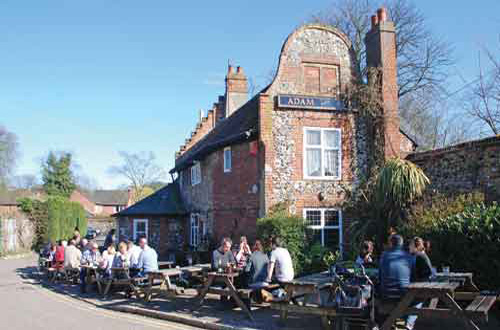
Many inns were called the Adam & Eve in the Middle Ages when the sign was the arms of the Fruiterers’ Company. It was common at this time for Eve to be depicted tempting Adam with an apple accompanied by a serpent coiled around the trunk of the ‘tree of knowledge’. In 1972 a new rather risqué sign was produced that excited so many complaints that the landlord had to return it to the brewery where the sign painters added two large, strategically placed fig leaves!
The Adam & Eve (Bishopgate Street) is believed to the oldest public house in the City still serving ales. Earliest references date back to 1249 when it was owned by the monks at the Great Hospital who used it as a brew house. At this time records indicate that it was frequented by labourers working on the cathedral who were paid with ‘bread and ale’. The original building was extended over the 14th and 15th centuries when living accommodation and the Flemmish gable ends were added.
It will come as no surprise that the Adam & Eve is supposedly haunted. The resident ghost is said to be Lord Sheffield who was killed in the vicinity during Kett’s Rebellion of 1549. However, in no way does he have exclusivity as it is also rumoured that sundry other ghosts often waft across from the nearby monks’ cemetery. If this weren’t enough the notorious 19th century killer James Rush was a regular at the Adam & Eve and is reputed to have plotted the murders of Isaac Jeremy, recorder of Norwich, and his son at the inn. Rush was captured and spent his last night in the dungeons of Norwich Castle before being hung in 1849.
Around the same time landlady Elizabeth Howes had an interesting sideline. She owned a wherry also called the Adam & Eve which she used to transport sand across from Yarmouth which she subsequently sold to local pubs for their floors and spittoons. On the face of it all was very respectable, however, hidden in the sand was contraband liquor which she successfully smuggled into Norwich for years! Artichoke
Many inns were called the Adam & Eve in the Middle Ages when the sign was the arms of the Fruiterers’ Company. It was common at this time for Eve to be depicted tempting Adam with an apple accompanied by a serpent coiled around the trunk of the ‘tree of knowledge’. In 1972 a new rather risqué sign was produced that excited so many complaints that the landlord had to return it to the brewery where the sign painters added two large, strategically placed fig leaves! The Adam & Eve (Bishopgate Street) is believed to the oldest public house in the City still serving ales. Earliest references date back to 1249 when it was owned by the monks at the Great Hospital who used it as a brew house. At this time records indicate that it was frequented by labourers working on the cathedral who were paid with ‘bread and ale’. The original building was extended over the 14th and 15th centuries when living accommodation and the Flemmish gable ends were added. Bell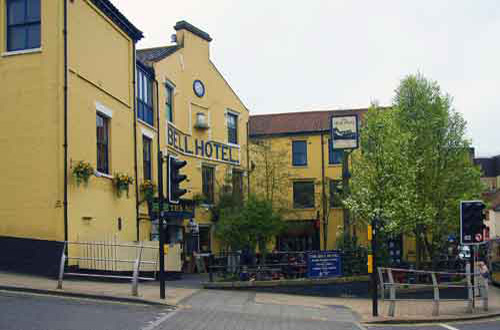
The Bell on Orford Hill ( known as the Blue Bell from c1763 to c1822), was likely to have been in existence in the late 15th century. By the early 18th century it was an established hostelry and a renowned venue for cockfights. Thus it was in 1725 that the landlord advertised that ‘…there will be a great cock match at the Blue Bell…to show 31 cocks…Gentlemen shall be accommodated with a glass of excellent wine and care taken to prevent disturbance by the mob.’
In the 19th century the Bell continued to be linked with a variety of clubs and societies. In 1858 it hosted the first annual dinner of the Norfolk and Norwich Anglers Society. In October 1881 was the venue selected to celebrate the golden jubilee celebration of the Eldon Club, which also held meetings here. Club members included the Duke of Wellington.
Around 1890 parts of the Bell which fronted the present main road from Castle Meadow were pulled down. Luckily the main part of building survived.
Over the 20th century fortunes were mixed. During WW2 it played its part in the war effort when it was used as headquarters and billets for the American Women's Army Corps. Although it was closed twice in the second part of the century on 12th December 1993 the popular J.D.Wetherspoon group opened their first pub in the City here and it continues to thrive today. Birdcage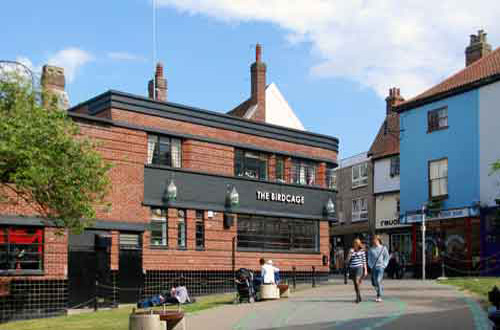
In 1937 the traditional building occupied by the Morning Star on Pottergate was demolished and replaced by the contemporary building we see today. It did not meet universal approval and in 1945 was described in the City of Norwich Plan as being ‘incongruous in design and out of place in an ancient street’.
In the late 1980s it was briefly operated by Colin Keatley, now very well known for his success at the Fat Cat. As you would expect from Colin at this time it sold a range of real ales. When he took it on it was known as the Brown Derby but he renamed it the Pottergate Tavern and engaged Cass Hooton to design anew sign.
Today it is the home of the Birdcage, which it is fair to say would not describe itself as a traditional pub and is probably best summed up on its website which reports that it is open every day for ‘wines, wifi, work and play, coffee, cup cakes, cabaret and cocktails, board games, bloody marys and a bit of Bohemia.’
Since opening five years ago they have also operated as a music venue playing host to a wide variety of artists and showcasing many local independent musicians and artists. Cat & Fiddle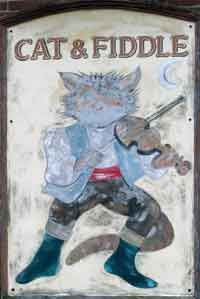
Until it closed (c.2011) there had been a Cat & Fiddle on Magdalen Street from at least the 18th century. There are many Cat & Fiddle public houses in Britain, indeed records show that historically there have been four located in and around Norwich. But what is the origin of the somewhat unusual name? Some suggest it could derive from chat fidele which is French for faithful cat. Another possibility is that it derives form Catherine la Fidele, Catherine the Faithful, a nickname for Henry VIII’s first wife, Catherine of Aragon. However, one should perhaps just look at the sign, apply common sense and assume it is taken from the old nursery rhyme: ‘Hey diddle diddle, The cat and the fiddle.’ But herein lies another tale. Some suggest that ‘Hey diddle diddle’ offers a cryptic commentary on Richard III’s path to the English throne. Following the death of his brother Edward VI, Richard took over the position of regent on behalf of his young nephew, Edward V. He than placed the young king together with his younger brother in the Tower from whence they mysteriously disappeared. The finger of suspicion pointed at Richard III but his subjects were too frightened to voice their worries openly, hence they used nonsense verse. Here ‘Cat’ refers to Richard’s aide Sir William Catesby, of whom it was whispered had thought up the ‘fiddle’ that put Richard on the throne. Catherine Wheel>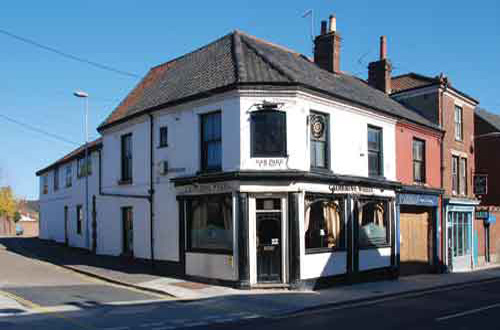
St Catherine, was one of the most popular saints in the Middle Ages. She lived in the 4th century and was daughter of the King of Cyprus. A number of legends are recorded as to why she was martyred at the hands of Emperor Maxentius, including both her refusal to marry him and to sacrifice to his gods. All do agree, however, that she was tortured and killed by being attached to a gigantic spiked wheel. Thus we have the birth of that most iconic of fireworks ‘The Catherine Wheel’. The Catherine Wheel was also adopted as the arms of the Knight of St Catherine of Mount Sinai an ancient order created for the protection of Mount Sinai. It is presumed that the Catherine Wheel, located at 61 St Augustines, along with many pubs of the same name adopted the name because of symbolic protection the knights offered to wayfarers.
The pub can trace its origins back to the 18th century. In 1790 it was in the news when it was reported “Dame Fortune has thrown £500 of the present lottery into the laps of thirty industrious individuals, who assemble as a club at the Catherine Wheel, St Augustine’s, in the city”.
Today the pub advertises itself as ‘Norwich’s favourite gay venue’ which prides itself on being friendly and fun. Here you can attend a variety of theme evenings including: quizzes, karaoke and cabaret. You can still view their 16th century well, a quirky fireplace (which following a revamp is now curiously located behind the bar) whilst from upstairs you can still view parts of the City Wall. Champion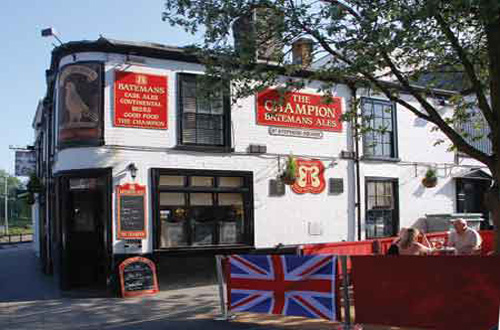
The Champion (Chapelfield Road) was named after the boxer Daniel Mendoza (1764 – 1836) who was an English prizefighter. Before Mendoza, boxers generally stood still and merely swapped punches. Mendoza introduced a new ‘scientific style’ which incorporated defensive strategies to avoid punches. As a result Mendoza was able to overcome much heavier adversaries. Despite standing at only 5'7" and weighing 160 pounds, from 1792 to 1795 Mendoza was England’s Heavyweight Champion and is the only middleweight to ever win the Heavyweight Championship of the World. In 1789 he opened his own boxing academy and published the book: ‘The Art of Boxing’. After retiring from the prize ring he toured England’s theatres, which included a visit to Norwich, with an act which depicted the various ‘heroic styles of great boxers’
The pub, now owned by Batemans, is a traditional pub which offers its customers a wide selection of real ales. Coach & Horses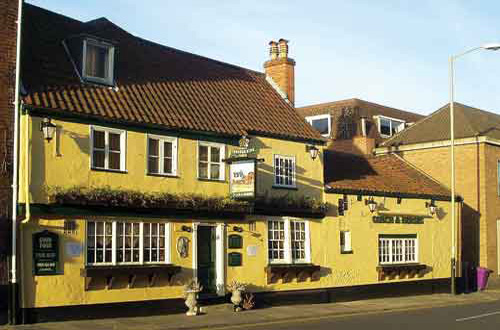
1710 is the date recorded on the wall of the Coach and Horses on Bethel Street, even so parts of the building are said to date back as far as 1200.
An old parish marker on the outside wall states that the inn lies between the parishes of St Peter Mancroft and St Giles and was the site of the once popular Ascension tide custom of ‘beating the bounds’ whereby choirboys were ‘bumped and dusked’ at their parish boundaries to ensure that they would not forget where the parish ended.
In 1987 it was swapped by Greene King for a Cambridge pub, and continues to be owned by them into the 21st century. Coach-
makers
Arms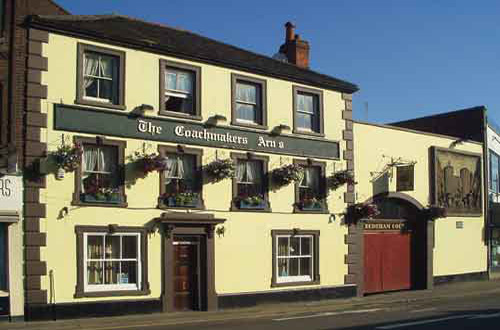
The licence to the Coachmakers’ Arms can be traced back to 1802, though it may have been trading before this date. On the outside wall hangs Moray-Smith’s bas relief of St Stephen’s Gate, based on a 1792 Ninham print. Made c1937 it is said to weigh a little under a ton and be the heaviest ‘inn sign’ in Norwich. The panel was made and modelled on site. The artist is still remembered wearing jodhpurs and bright red stockings stood on scaffolding outside the pub putting the finishing touches to his work. The Coachmakers’ Arms continues to retain a small cobbled coach yard, which is now a sheltered seating area. Compleat Angler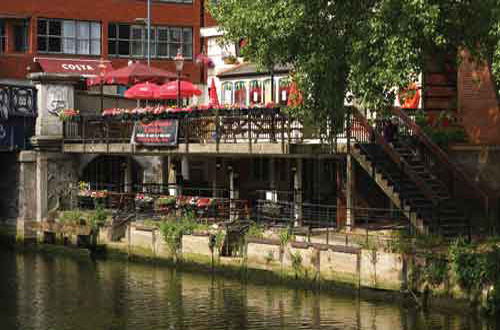
Seeing the opportunity to provide refreshments for travelers, on January 13th, 1851 Richard Bullard bought the Foundry Bridge toll house (Prince of Wales Road) from the Norwich Corporation for the princely sum of £430 and converted it into the Norfolk Railway House, sometimes called the Toll House.
The pub contained an annexe called the Blue Room. Built practically on the bridge you could walk through it onto the river walk. Through the years it has had many uses. In the 1930s it had a reputation for being used by working girls. Moving onto the 1950s there were still many American airmen stationed in Norfolk, however, some pubs refused entry to black Americans. Not so at the Blue Room. Despite the risk of losing the trade, black airmen were welcomed in and it became one of their main meeting spots in Norwich.
In 1973 it was closed for refurbishment, reopening in 1974 as the Compleat Angler in recognition of its proximity to the river. The ‘Compleat Angler’ in question is a book by Isaac Walton. First published in 1653 it is a celebration of the art and spirit of fishing.
The pub continues to be very popular today with its patio overlooking the river and of course its proximity to the railway station. Cottage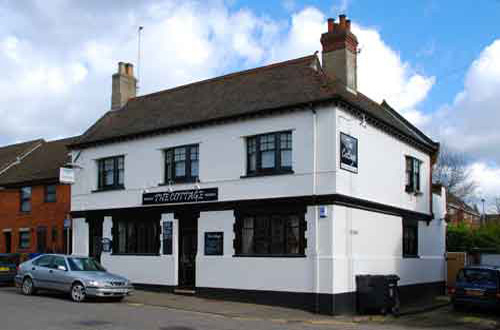
The licence can be traced back to 1830. Within ten years of opening it was the subject of some concern when it hosted meetings of a radical Chartist club inspired by John Love, Norwich’s first Chartist leader. Other public houses where gatherings took place included the Angel (Oak Street) and the Shuttle (St Augustine’s). Unsurprisingly all were located in the poorest areas of Norwich. For many years the Cottage was tied, however, it is now a freehouse and is able to offer its customers up to ten beers on hand pump from breweries across the country supplemented by a selection of continental draught beers and a wide selection of spirits. For music lovers the pub hosts weekly gigs performed by some of East Anglia's finest talent whilst regular quiz nights are held for those who want to put their general knowledge to the test. Delaneys St Andrews Brewhouse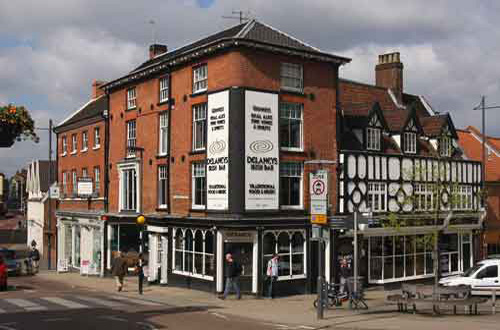
On the August 1st, 1898 a fire broke out at Chamberlin’s department store which occupied a block fronting Guildhall Hill that stretched back along the length of Dove Street. Luckily the Edinburgh which was stood next door to the store appeared unaffected, then four days later just after the end of lunchtime trading the building collapsed. It was decided to transfer the licence, to premises on St George Street, which at the time was a grocer’s shop and open the Festival House. It took its name from the Norfolk and Norwich Triennial Music Festival which was first held at the nearby St Andrew’s Hall in 1824 and in its time played host to such great musicians as Edward Elgar and Vaughan Williams.
Until 1980 the corner bar was a Victorian gem complete with carved wood and mirrors. Unfortunately around this time it was ‘modernised’ and the bar was removed. Subsequently from 1992 to 2000 it was renamed several times, at one point being called the Grocer’s Ghost in memory of the buildings earlier use.
From 2001 to 2015 it operated as Delaneys, a very popular Irish theme pub. After which it was reinvented as St Andrew's Brewhouse, complete with a microbrewery and smoke house. Doghouse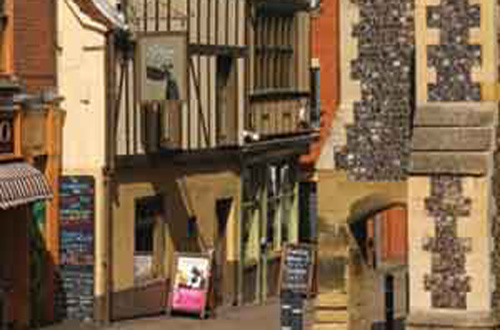
The building occupied by the Red Lion on St George’s Street is around 300 years old. An Elizabethan ordnance of a previous establishment states that the innkeeper was accused of harbouring ‘ill disposed persons and playing unlawful games with them day and night to the displeasure of Almighty God and to the evil example of others’.
In the 1950s and 1960s the Red Lion was part of the music scene and was one of the first Norwich pubs to feature a skiffle group, namely the Alley Cats.
In 1973 Courage brewery undertook a £27,000 conversion during which an impressive inglenook fireplace was uncovered.
For many years the Red Lion was the nearest pub to the Norwich School of Art, now transformed into the Norwich University College of the Arts, and was a favoured meeting place for staff and students, both past and present.
The Red Lion closed c2005 and following a further conversion it reopened as the Doghouse Bar. Edith Cavell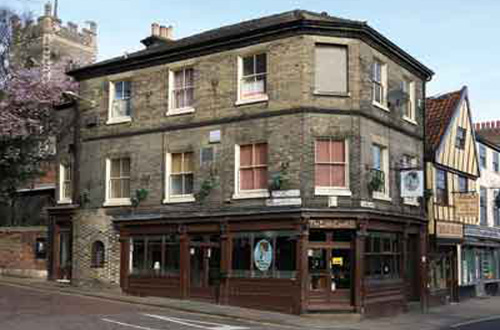
The Tombland Stores (Tombland) originally opened as a beerhouse in 1870. In the early 20th century it was briefly converted into a clothing shop. When it opened again as a tavern it was rechristened as the Army & Navy stores after a home for soldiers and sailors on Queen Street. In 1975 it was described by John Riddington Young as being: ‘A tourist attraction in the summer for those foreigners who wanted to see “an English pub”. The etched windows indicate where the original rooms used to be. The best example faces the cathedral and bears the endearing epithet “Jug and Bottle”. The back of the bar is a fine example of Victorian pub décor.’ In 1994 it was rechristened after local WWI heroine Edith Cavell, who is buried in the nearby Cathedral Close. Escape
A pub has been trading on the same site at, 102 Magdalen Street, since the 1830s. Around 1950 it became the property of Messrs Backs, when it was one of their famed freehouses. During this time a huge barrel was hung outside as a sign that Backs kept their cellars fully stocked. This led to the house being known locally as the ‘Tub’. Other public houses in the Backs empire included the Curat’s House and the Vine Tavern. In the early 21st century it traded as “The Escape European Bar”, before being reinvented as the Cactus Cafe Bar. Fat Cat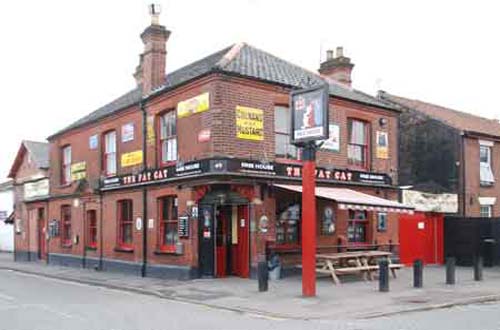
The Fat Cat is one of Norwich’s most successful pubs of modern times. As we write it has twice been named the CAMRA National Pub of the Year whilst the Good Pub Guide has awarded it the title of Beer Pub of the Year, no fewer than four times. So although it is located outside the 1884/5 City-centre map, we decided that it had to be included.
Going back to 1868 the hostelry was owned by Steward & Patteson and it traded as the New Inn. During 1972, whilst owned by Watneys, it was one of 42 pubs in the City swapped with Courage as part of a government-enforced scheme aimed at bringing more competition to the market. In 1991, when it was bought by Colin and Marjory Keatley, it was sold by Courage as a failing ‘bottom end’ pub. Following his tenure at other City hostelries, including the White Lion (Oak Street), Colin was already building up a reputation for selling real ales. When he bought the New Inn he was particularly inspired by the ethos of the Fat Cat pub in Sheffield and decided to rechristen the New Inn accordingly. Subsequently it was closed for five months during which time the premises were refurbished. It reopened with a new décor and, more importantly, four hand pumps. Today the décor remains simple. On the walls is a superb selection of pub memorabilia, including wonderful old pub signs, indeed its worth visiting just to see these. The Fat Cat is one of the few, successful hostelries which doesn’t sell cooked food instead clientele are offered an extensive range of beverages including real ales from no fewer than 12 hand pumps. Amongst the ales on sale are those produced by the Fat Cat Brewery on Lawson Road (Norwich) which was opened in 2005. Located behind the Brewery Tap (previously the Shed) its opening was the realisation of Colin’s dream to operate a brewery. Its brews have included: Marmalade, Cougar and Cat & Canary (the latter in support of Norwich City Football Club aka The Canaries). Freemason Arms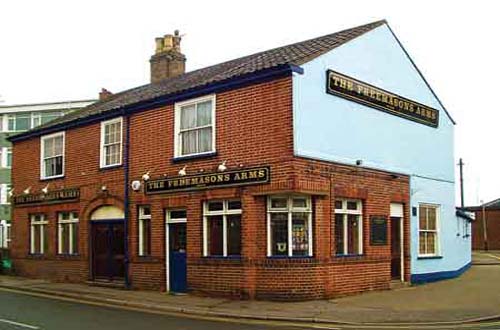
The original Freemasons’ Arms (Hall Road) was a much smaller alehouse than the pub which still trades today. It expanded when the brewery took over the adjacent post office. From 1885 to 1912 the landlord was well known local sportsman George Rye. In his day George was one of Norfolk County Cricket Club’s best medium-paced bowlers. He subsequently refereed many a match at the Lakenham ground after which he just about managed to sprint back to the pub and be ready for the crowd who would call in to discuss the match over again. During George’s reign the pub naturally became very popular with many local sportsmen including cricketer ‘Bones’ Howlett and boxer ‘Cock’ Blyth. Between 1994 and 2005 the premises were taken over by Woodforde’s Brewery who asked for suggestions for a new name and couldn’t resist calling it after Norwich character Billy Bluelight (c1860 – 1949) who was renowned for standing outside pubs and factories extolling the virtues of abstention. When Woodforde’s sold the pub the name reverted back to the Freemason’s Arms, and Billy could rest easily again. Gardeners' Arms (Murderers)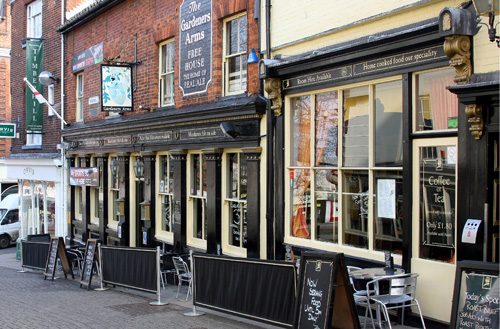
The licence of the Gardeners Arms on Timber Hill can be traced back to 1841 but the building itself dates back to 1696. It has a fascinating history. Since the early 20th century it has been better known as the Murderer’s Arms. For many years it was believed that it received its somewhat sinister nickname after a prostitute who frequented the tavern was murdered by a client.
In 1970 the pub was closed by Watneys and for a time it was used for a charity shop. Then in 1976 it was reported that Douro Potter the ‘uncrowned king of the city centre pub trade’, working with partner Ray Lince, was about to spend £20,000 on renovating the premises. At the time they wanted to officially change the name to the Murderer’s Arms, however, tentative enquiries at City Hall were not encouraging. Undeterred Ray arranged for the ‘Muderer’ to be depicted on the one side of the pub sign and the ‘Gardeners’ on the other, an arrangement which carries on today.
The pub continues to be very popular in fact in 2009 it was listed in the Lonely Planet travel guide as a ‘must visit’ attraction which since taking over an adjacent property now also incorporates the Murderers’ Café Bar. Glass House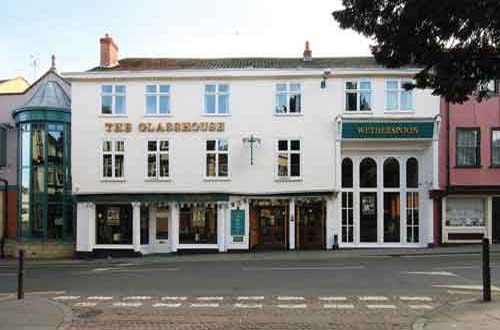
In 2001 the Glasshouse (Wensum Street) was the third J.D. Wetherspoon pub to open in the City centre. As its name suggests it is partly housed in the premises of a former glass merchant. The premises is light and airy and with an attractive outside seating area. The chain was founded in 1979 when the 24 year old law graduate Tim Martin opened his first pub in Colney Hatch Lane, London. Wetherspoon’s champions cask ale, low prices, long opening hours, and no music It is said that Tim named his business after a tutor, a Mr Wetherspoon, who had written on his report card: ‘Tim will probably amount to nothing.’ The initials ‘J.D.’ were added in honour of Tim’s favourite television character of the 1970s, J.D. Hogg from the Dukes of Hazard. Golden Star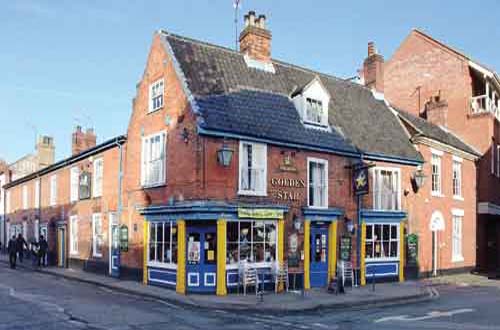
The licence of the Golden Star on Duke Street can be traced back to the 1860s. In 1970 It was closed by Watney Mann and it seemed that the building was likely to be demolished. Then in 1975 Peter Turner negotiated the lease from the City Council and he, together with his wife Carol, got to work. This is their story:
‘When we moved in during 1976 it was derelict and inside was positively grim. We had to do a lot of work before we opened which included knocking down walls and a total refurbishment. We didn’t have carpets but wanted to create a traditional drinkers pub with bare floorboards, wooden panelling and wooden seats. We even had a mulling iron which stood by the open fire in the back bar for those wanting to drink mulled ale.
In 1984 when Carol and Peter sold the Golden Star to Greene King the Evening News reported that ‘there was genuine sadness at the demise of the pub which had been a last bastion of resistance to juke boxes, video games and fruit machines…It was the end of an era’. On their final night at the pub a wake was held which spilled onto the streets outside. Performers who had met at the pub including the Golden Star Morris entertained the crowds.
Two hundred customers, who feared that Greene King would alter the Star’s interior and ruin its unique character, signed a petition. The new owners listened, retained the old Star spirit and opened to ecstatic review and it continues to trade today Hog in Armour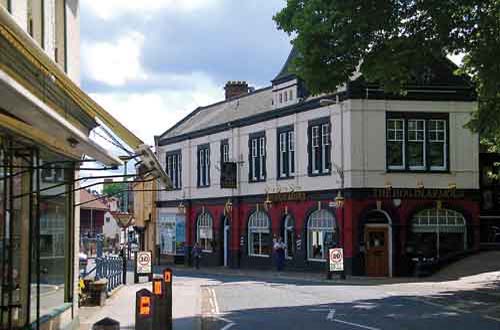
In 1891 the Three Pigeons, which was located on the corner of St Benedict’s and Westwick Street, was destroyed to allow the road to be improved. The licence was transferred to 16, Charing Cross were the pub continued to operate. In 1977 its name was changed to the Hog in Armour which it still trades under today.
The term ‘hog in armour’ appears to date from the 18th century and seems to be a variation on the phrase that you can’t make a silk purse out of a sow’s ear. The original sign was painted by Peter Burrows and very much reflects the view of the Baptist preacher Charles Spurgeon (1834 – 92) who said : ‘A hog in a silk waistcoat is still a hog.’ Kings Arms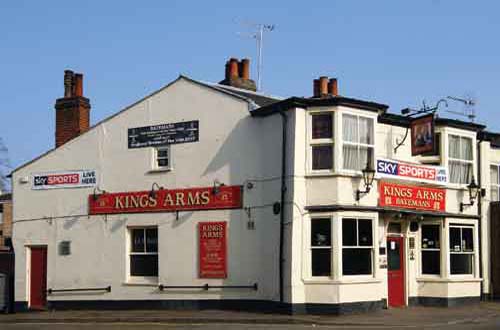
The King's Arms was built in 1824 and first licensed 1830. Around 1855 Thomas Cott, a pawnbroker, sold it to local brewers Charles Crawshay and John Youngs for £545.
From 1951 to 1973 the pub was presided over by popular landlord Charlie Drake who became so well known the pub was just referred to as ‘Charlie Drake’s’. After being a tied house for a number of years in 1998 it was purchased by John Craft and Nicky Howard who ran it as a freehouse selling a wide range of well kept cask ales.
In 2004 it was bought by Batemans’ Brewery of Wainfleet who carried on John and Nicky’s good work. In fact the King's Arms has gone from strength to strength and has the accolade of being listed in all CAMRA Good Beer Guides this century!
The King's Arms is a traditional city pub that takes pride in offering a great selection of: real ales, imported draught lagers, cider and a range of bottled Belgian beers together with a wide selection of wines and spirits. It considers itself a ‘proper local’ and is well set up having both a beer garden and conservatory. It is a favourite with Norwich City fans before and after games but always welcomes away fans, as long as they appreciate real ale! Although food is available at lunchtimes in the evenings customers are encouraged to order food in from one of the many local take-aways. The landlord than supplies: plates, cutlery, napkins and condiments enabling diners to enjoy their meals in comfort. Kings Head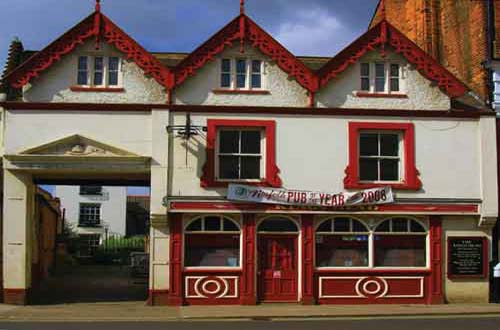
The licence of this pub, located at 42 Magdalen Street, can be traced back to 1760 and remarkably 300 years later it is still trading. Despite an extensive renovation 2004/5 the entrance to the adjacent court still depicts the emblem of the Crown Brewery, dating back to when it was tied to Youngs, Crawshay & Youngs. Also you can see the gargoyles with their crown clearly depicting a ‘king’s head’ between the windows. The image on the sign seems to be based on King Richard II. Adjacent to the pub is an excellent example of an old Norwich Yard. The building has recently been restored but still retains a traditional feel. As would be expected from an establishment which has been given the award ‘CAMRA Pub of the Year’ it boasts an impressive selection of real ales which are served in a welcoming friendly atmosphere. On top of all this the King’s Head is one of the few pubs in the area with its own bar billiards table and even hosts a league. Lamb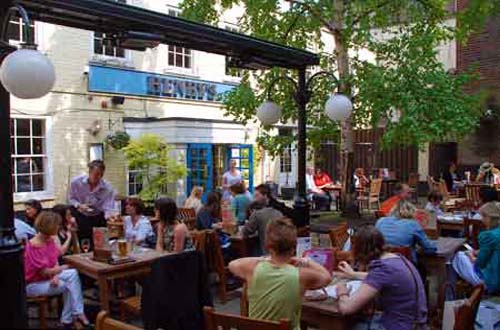
Following the Norman invasion in 1066 a Jewish Ghetto was established in the area between the Haymarket and White Lion Street. In 1296, four years before Edward I expelled all Jews from England, it was ravaged by fire. Subsequently part of the area, including that now occupied by the Lamb (Old Haymarket), was settled on the Church of the Mass of Jesus, in nearby St Peter’s. When an inn was established it was given the suitably ecclesiastical name of the ‘Holy Lamb’ later abridged to the ‘Lamb’.
More recently in 1979 the premises was renovated. It was decided that spreading sawdust on the floor would create an authentic and convivial atmosphere, a view not shared by the health and fire authorities who condemned the building as a fire hazard. It subsequently reopened with a brand new carpet! Then in 1996 there was much consternation in the City when the ancient house was renamed the Rat & Parrot eventually becoming ‘Henry’s Cafe Bar @The Lamb Inn’. 2011 saw this historic inn given a traditional décor ‘with a modern twist’ and rechristened as the Lamb, although to be fair, locals have never called it anything else! Lawyer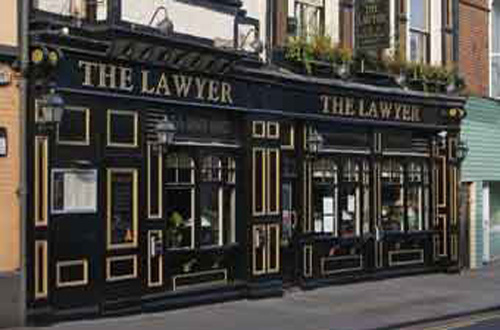
In the late 18th century a Joseph Geldart occupied these premises on Wensum Street where he operated as a wholesale and retail dealer in ‘wine, brandy, rum and other sprits’. In the early 19th century the premises was licensed as the Grapes. Between 1911 and 1972 it was part of the local chain established by P.G. Back. Subsequently it underwent many name changes. It has recently been attractively refurbished and renamed as the Lawyer and prides itself on offering ‘… real ales, premium lagers, a huge wine selection and fantastic authentic Thai food.’ Leopard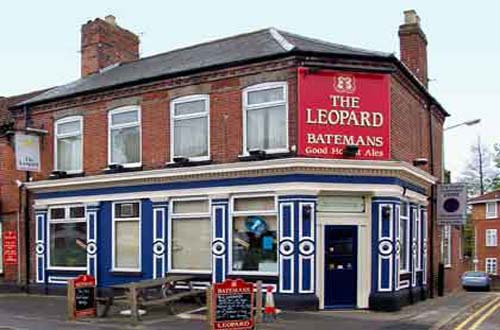
The Leopard, on Bull Close Road, can trace its licence back to the early 19th century. Normally when an animal appears on a pub sign it is of heraldic origin and design which is why we have so many White Horses and Red Lions. It is rare that a non heraldic, aggressive animal gives its name to a pub yet in this vicinity we once had both the Leopard and the Tiger. No one is quite sure why although it isn’t beyond the realms of possibility that the signs were once very badly painted lions, alternatively it could be explained by the cavalry telling of their exploits whilst defending the Empire.
From c.2007 the premises was owned by Batemans who sold it in 2013 after which it operated as a freehouse. Macawber's Tavern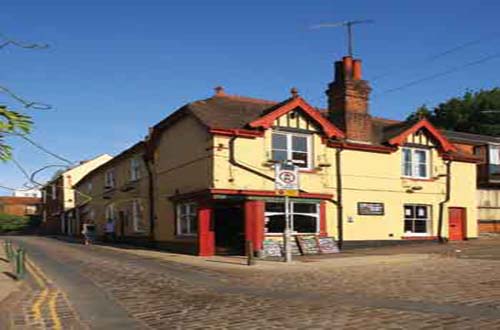
The Alma on Pottergate was built in 1772. It was originally called the Duke of York but was renamed the Alma c1856 to commemorate Lord Raglan’s victory over the Russians in 1854, in what was the first key battle of the Crimean War.
John Riddington Young recalls the autumn of 1971 when a party was held to mark the closure of the pub. The dartboard and ashtrays were given away and festivities extended well beyond closing time. The following morning the Brewery paid a visit to the licensees, Jessie and Billy, to tell them there had been a mistake and it wasn’t to close at all. So the dartboard was returned and another party was held to celebrate the reopening!
It did, however, finally closed c1975 before being reopened as Micawber’s Tavern in 1977 a name which , despite a brief period as Seamus O’Rourke’s, it still holds today. Marquee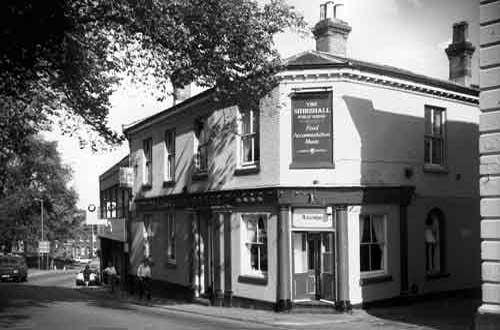
Being close to the Cattle Market the Shirehall Tavern (Cattle Market Street) was very popular with farmers and dealers who could use the large yard at the rear to store pigs and cattle. It is also reputed to have once provided lodgings for judges sitting at the nearby Shirehall, the building which gave the establishment its name.
Historically the Shirehall was the centre for jurisdiction and administration for the county. As early as 1270 a Shirehouse was located next to the Castle and was subsequently rebuilt in 1579 on the castle mound. In 1821 it was relocated to the base of the mound, where it stands today. It is still linked to the Castle by a tunnel which was originally used to take prisoners between the courts and the prison (which was locatedin the Castle). In 1988 the courts moved to a new site by the Cathedral and the building now houses the Regimental Museum and Norwich Castle Study Centre.
In the latter part of the 20th century the pub has enjoyed mixed fortunes and a number of name changes. In the early 21st-centry it was christened as the Marquee, when it developed as a popular entertainment venue featuring comedy and live music. It subsequently changed its name to the Owl Sanctuary, the name deriving from the comedy show 'I'm Alan Partridge'. It has since closed. Mischief Tavern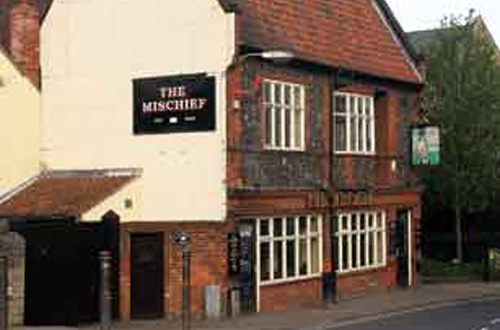
The Wine Vaults on Fye Bridge Street was housed in 16th century merchant’s house. From the 1890s it traded as Carter Steward and co Wine Vaults than in 1963 was rechristened the Mischief, a name it still holds today. At one time a copy of Crome’s version of Hogarth’s sign of the ‘Man Loaded with Mischief’ hung here. The sign depicted a man with a careworn face. A chain labelled ‘wedlock’ hung around his neck and bound him to his wife whom he carried on his back. She in turn drank a glass of gin whilst supporting a monkey and a magpie, symbols of mischief and strife. In today’s politically correct world the pub sign is much more acceptable depicting as it does a mischievous little boy.
In 1964 local jazz legend Albert Cooper, together with his brother Tony, launched a new folk club at the Mischief: ‘It was my brother Tony’s idea to start the Jacquard club. Folk music was becoming prevalent and he already had experience as he ran a trad jazz club called “Jazz at Studio 4” based at the back of Anglia TV. We looked around for a room and eventually found one at the back of the Mischief Tavern. It used to be the pub brewery and had a sloping floor and a gutter running through the middle. The landlord Leslie Izzard and his wife Billie agreed to let us use it every Thursday.We wanted a folk oriented name with a bit of history to it. We came up with the Jacquard club after Joseph Marie Jacquard who invented the first automated loom which was used to make Norwich Shawls. ‘You could fit in eighty people at a squeeze. Mind you it was than so packed you couldn’t move. Performers included Judy Collins and Paul Simon. They didn’t want much, I suppose we paid them about £15 in those days, which was a fair bit but not a fortune. I performed as “Albert and the Jacquards” backed by Gerry Parish and Dave Keeley. No 12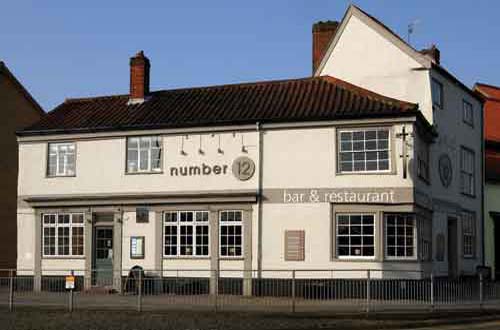
The Plough (Market Avenue), sometimes called the Plough & Horses, would have received its name because of its proximity to the Cattle Market.
After being bombed in 1943 it was closed as a public housed but was used by the American Army as headquarters for the Military Police. In 1973 it was taken over by Douro Potter and renamed La Rouen. After trading for over 150 years it was temporarily closed c1995 after it was disovered that the Castle Mall development had undermined the building.
Today it trades as the Number 12 bar and restaurant where customers can relax in rooms full of charm and character. Plasterers Arms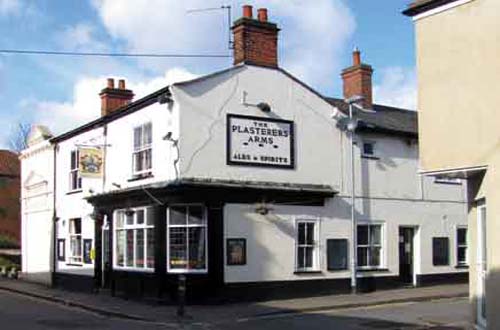
This is one of the many taverns in the City which bore the name of some trade or occupation. Typically the name would be given to an establishment where workers met either socially or to discuss the business of their guild. Often, as happened here, the tavern would take on the name of ‘Arms’ which would then be depicted on the pub sign. Interestingly the Brickmakers and Plasterers, both from the building trade, appear to have been based within 200 yards of each other. The pub sign still depicts the actual Arms’ of the Plasterers with its motto of: ‘ Let brotherly love continue.’ The central shield contains images of a trowel between two plasterers’ hammers whilst below the chevron we see a plasterers’ bush. The licence of the pub, which still trades in 2011, can be traced back to the early 19th century. In the mid 1970s it became a real ale hot spot when in 1976 it was bought by Derek Howard, who also owned the Ten Bells on St Benedict’s, for £12,600. Pete Turner, later landlord at the Golden Star, remembers it well: ‘ At the time it was virtually impossible to get draft beers. You could get Adnams at the Maids Head and Worthington E at the Wild Man, and that was about it. I think that these were the only free houses in Norwich. We sold Tolly Cobbold, Adnams, Greene King, IPA and Abbott. Customers used to walk through the door of the Plasterers and see the six hand pumps, fall on their knees and bow down in front of them. It was real ale Nirvana. The crowd at the bar was regularly six deep it was a real scum. When we cleaned in the morning we’d find £5 and £10 notes in the rubbish on the floor.’ Plough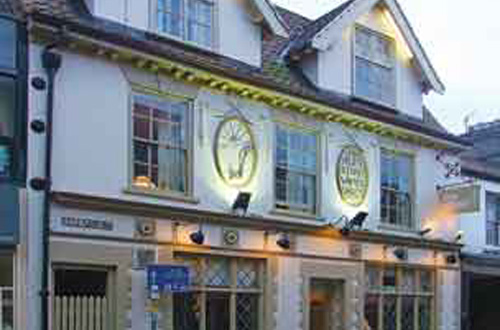
The Plough (St Benedict’s Street) is located in a 17th-century merchant’s house. The pub gave its name to both Plough Yard and Little Plough Yard, which it stands between.
A plasterwork plough in a distinct ‘Wedgwood’ style is highlighted on the front wall. The sign was popular in agricultural areas and Norwich’s other Plough, which stood near to the Cattle Market on Farmers’ Avenue, had this connection. The plough was also the main heraldic device on the Crawshay family’s coat of arms.
In 2009 the Plough was closed and subsequently bought by the Grain Brewery, a small venture located in the Waveney Valley. Following an extensive renovation it was reopened in April 2010 to rapturous reviews. Particularly popular is the beautiful beer garden, a rare commodity in Norwich. Prince of Wales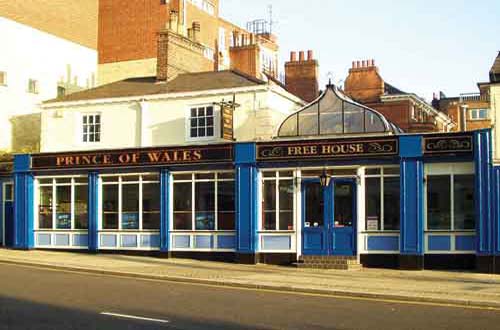
The Prince of Wales (Prince of Wales Road) has operated from here since the late 19th century. Despite being damaged during raids in April 1942 it still trades from the same site today where it is now located adjacent to some of Norwich most popular nightclub venues. Red Lion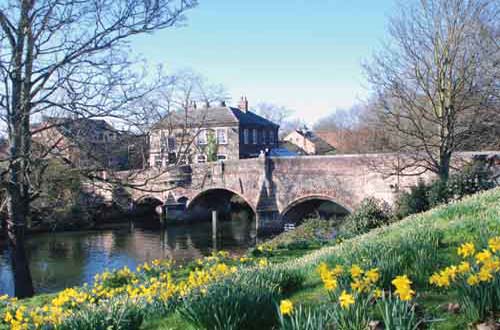
The Red Lion along with the Adam & Eve (both located on Bishopgate Street) were once owned by the monks who resided at the nearby Great Hospital. Parts of the building it still trades from today can be traced right back to the 16th century. In the 1970s it was renowned for its musical evenings and it is said to have been the venue where the Mutton Chop Banjo Band was launched! Ribs of Beef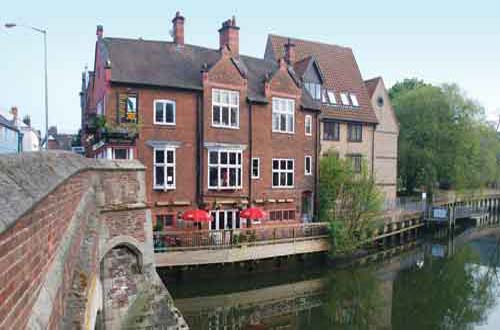
The Ribs of Beef is one of Norwich’s most popular City Centre pubs. As early as 1743 it was operating as a licensed premised. In 1898 the front half of the building was demolished as part of a road widening scheme to allow electric tramway tracks to be laid, nevertheless the remaining building was rescued and the pub reopened in 1904. In 1929 it was renamed the Fye Bridge Tavern in anticipation of the new twin span bridge which was built to alleviate the River Wensum flooding the city as it had in 1912.Then in 1958 the pub was delicensed. Over the following years the building housed an antique shop, an electrical shop and a ladies fashion boutique before Roger and Anthea Cawdron relicensed it in 1985 as the Ribs of Beef. Most real ale pubs at the time had floorboards and benches but the thick carpet and leather seats appealed to the locals and professional clientele who required more comfort. Serving a range of cask ales from all over the UK and excellent food and wines it quickly established itself as ‘the City's favourite local’. Rose Tavern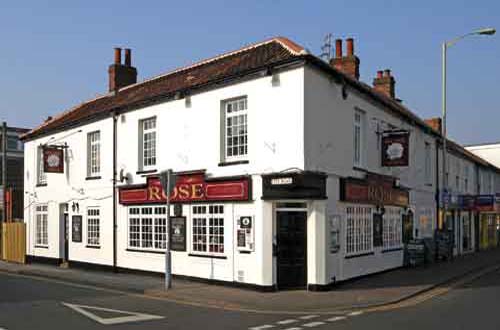
The Rose (Queen’s Road) was first licensed in the mid 19th century. Since then it has been known as the Rose Tavern, the White Rose and today simply as th Rose. It's proximity to Carrow Road means it is particularly popular on match days.
Rumsey Wells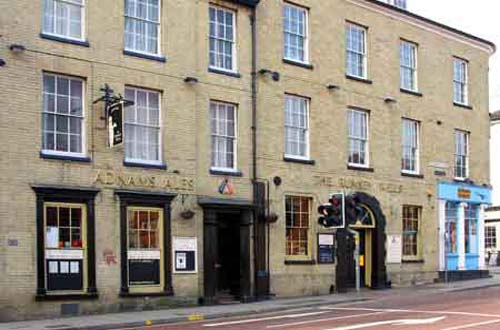
The licence to the Shrub House, originally located at 2, St Andrew’s Street, can be traced back to 1842. Originally it was the premises of Ward & Seaman who traded in wines and spirits. In 1974 the premises was extended to incorporate 4, St Andrew’s Street which had been Wells & Son hat shop.
In 1979 the Shrub house closed and the original corner bar (2, St Andrew’s Street) became a newsagents. Around 1984 the remaining property was reopened as Blueberries. It has since traded as both the St Andrew’s Tavern and the Rumsey Wells. Today it trades under the latter name and prides itself on providing premium booze, including a good selection real ales and foreign beer, pub grub that ‘resembles good British home cooked food’ and regular live music. Steam Packet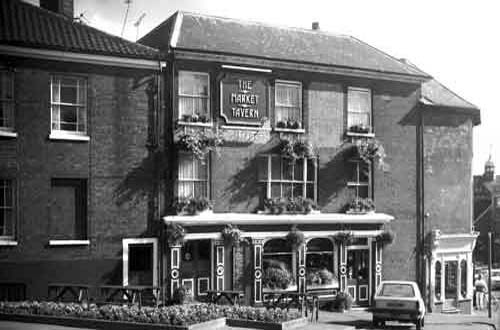
There were three Steam Packets open within the City centre in 1884. The definition of a steam packet is ‘a ship that sails a regular route between two ports’. In the late 1800s such a steam ship travelled from Norwich to Bramerton Woods End, Coldham Hall and other riverside resorts. The Steam Packet on Crown Road has undergone many name changes since it opened c1840. Not surprisingly, in view of its vicinity to the Cattle Market, for most of the 20th century it was called the Market Tavern. It was here that farmers would have come to make many transactions. However, in 1993 it was once again christened the Steam Packet Tavern, a name it retained into the 21st century. Sir Garnet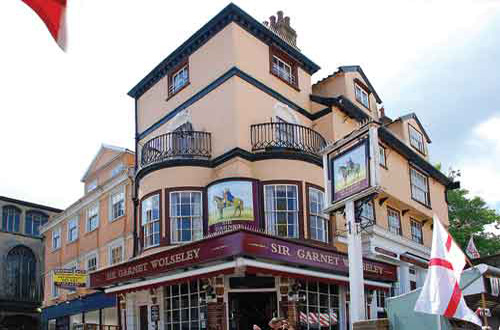
The Sir Garnet (Market Place) started trading as a public house c1861. It was originally called the Baron of Beef, possibly because the premises used to be a butcher’s shop. In 1874 the house was renamed the Sir Garnet Wolseley, at which time a new Baron of Beef opened in premises standing on the corner of Gentleman’s Walk and the Market Place.
It was named after Field Marshal Garnet Joseph Wolseley, 1st Viscount Wolseley who, in the same year the name was adopted, had received accolades for his brilliantly executed Ashanti campaign. The Field Marshal’s reputation for efficiency led to the late 19th century English phrase ‘everything’s all Sir Garnet’, meaning ‘all is in order’.
In the 20th century the pub extended in size when it took over 37, Market Place, which had previously traded as the Punch Bowl. Today, as it has been throughout its long history, it is easily recognisable by its distinctive curved balconies which overlook the Market Place. Surrey Tavern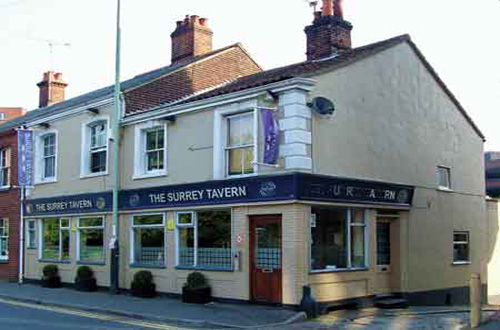
The Surrey Tavern took its name from the street it stands on. In turn, Surrey Street was thus named in Tudor times, when the Earl of Surrey lived there. His mansion has long since disappeared. It was replaced in 1905 by the opulent Surrey House, designed by George Skipper as the new headquarters of the Norwich Union Life Insurance Society, now Aviva. For many years the hostelry was very popular with Aviva staff whose offices are located nearby. It has since reinvented itself as a cafe bar. Temple Bar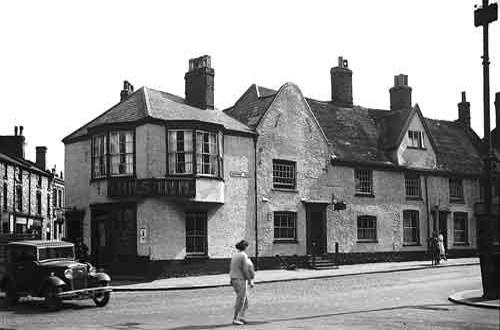
The Tuns (Unthank Road), now rechristened the Temple Bar, survived when many of its immediate neighbours were demolished to make for the new inner ring road. It used to be thought that the house was as old as the Adam & Eve (Bishopgate), however, this listed building is now known to date back only to the 17th century. Its age has been ‘disguised’ by a 19th century façade.
In the 1860s, when election fever ran high, the Tuns espoused the cause of the ‘Orange and Purples’ (the Tories) whilst the nearby Grapes Hotel (Earlham Road) was a ‘Blue and White’ (the Whigs) stronghold. During the elections each house would put a placard announcing the ‘state of the poll’ on an hourly basis which led to many lively altercations on the plain separating the two establishments.
From 1892 to 1911 the Tuns was presided over by landlord ‘Bob’ Booty, who as a sideline drove the Judges’ carriage. Booty built a reputation for putting on convivial evenings remembered nostalgically by Walter Wicks who recalls him serving ‘tradesmen’s suppers of rabbit and neat’s cheek, sumptuously served, invariably followed by an excellent smoking concert, when some of the best amateur talent in the county contributed to the harmony of the evening.’ Ten Bells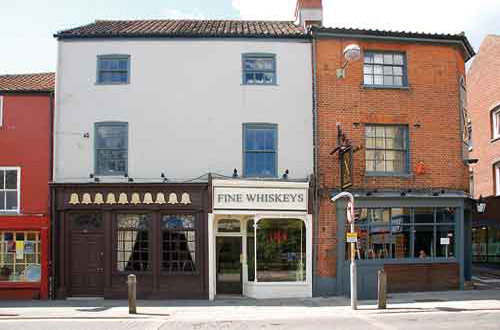
There has been much speculation as to the origin of the Ten Bells name. It has been trading here since at least the 18th century and is thought to allude to the fact that at one time you could stand on this stretch of street and clearly hear the bells from ten different churches. Today it is tied to Greene King, however, in the mid 1970s it was a free house and one of the few places in Norwich that you could buy real ale. Trafford Arms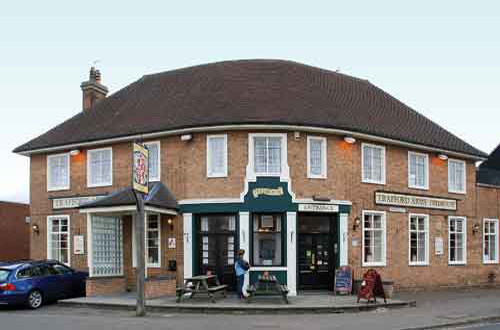
The Nursery Tavern can be traced back to 1865. It is possible that the first landlord, Robert Allen, continued his horticultural activities as well as being a publican, hence the name. In 1886 the Nursery Tavern was demolished and the licence was transferred across to a new building that was erected on what is today 61 Grove Road. The new premises, renamed the Trafford Arms, continues to trade on the same site today - depite a number of setbacks.
In March 1895 disaster struck the Trafford Arms when a three hour cyclone blew two large chimney stacks through the roof of the pub. It was repaired than on 27th May 1942 it was severely damaged by bombing. As a result on 15th October 1942 the licence was suspended because of ‘war circumstances’. There was some concern that if the pub did not reopen within a short time scale that the licence may be forfeited. As such between August 1943 and 17th November 1955 the Trafford was run by the landlord and his wife, Cecil and Doris Clarke, in a temporary wooden building converted from a large broiler house, known as the ‘Chicken House’. In autumn 1955 the first half of the present building was completed. The pub closed one evening in the Chicken House and reopened the next morning in the new wing (no pun intended) which later became the bar.
Trowel & Hammer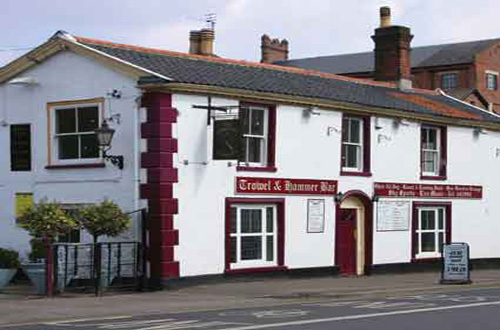
Around 1700 the tavern was known as the ‘Spittle House’, believed to be a corruption of the word hospital, as it is documented that it was frequented by ‘lepers, lame and decrepit persons’. By 1755 it was known as the ‘Lazar House’, ‘lazer’ being an old term for leper. By 1811 it was operating as a tavern. It is assumed that the name relates to a trade guild, however, it is also possible that an early landlord was a freemason. In 1829 the artist William Martin (1753 to 1831) was lodging here in very poor circumstances. Martin had painted two large pictures namely ‘The Death of Lady Jane Grey’ and ‘Queen Eleanor, Consort to Edward I’, both of which hung for some time in St Andrew’s Hall. Around the same time he was voted a grant of 100 guineas by a sympathetic Norwich Corporation.
Although for five years from 1997 it was transformed into Finnegans Wake, an Irish theme pub, this friendly tavern still trades today as the Trowel & Hammer. Vine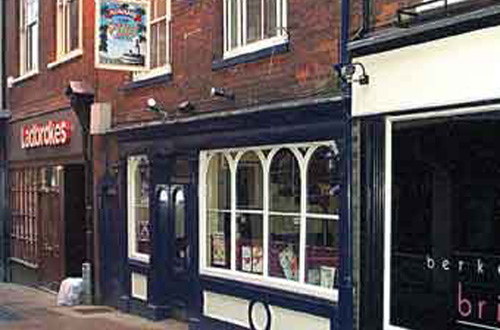
The Vine (Dove Street) is possibly best described as ‘small but perfectly formed’, but this has not always been the case.
The licence can be traced by to 1842, however, it closed in 2006 and the end seemed nigh, however, in 2008 it was rescued and reinvented. Today, despite being hailed as Norwich’s smallest pub, the owners have managed to integrate a pub with a Thai retaurant. This has been achieved by combining two miniscule rooms downstairs into an area containing four small tables and a mini bar whilst the dining room is upstairs. Even more remarkable, given the limited space, in 2011 the Vine made its way into the Good Beer Guide. Walnut Tree Shades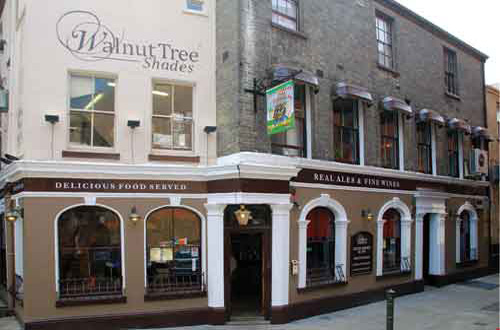
The licence of the Walnut Tree Shades (Old Post Office Court) can be traced back to 1841.
John Riddington Young speculates that although this would be a name/ sign frequently adopted by cabinet makers, there is no evidence that this was the case here. In the past the premises were used by the Norwich Brewery as an outlet for trial brews and apparently Starlight was first sampled here!
For many years the premises successfully traded as an American bar and diner. It has recently been sold, renovated and decorated and is now offering its clientele live bands, good food and a selection of ales. White Lion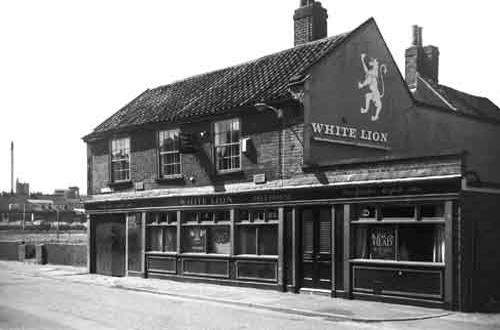
Parts of the building which house the White Lion (Oak Street)can be traced back to the late 16th century. In 1884 it was one of the many pubs trading along Oak Street, today it is the only one still trading. In April 1942 Oak Street was badly hit during the Baedeker Raids. Although the White Lion survived the old Empire Picture House was badly damaged and all the little yards leading from Oak street were hit including : Little Buck Yard, Royal Oak Yard, Old Brew Yard and Angel Yard. It survived again when the Courtaulds factory, its immediate neighbour, was burnt out.
In 1980 Colin Keatley (who now owns the Fat Cat pub and brewery) bought the White Lion and turned it into a real ale house. At the time it was one of only a handful of pubs selling real ale in the City. It coincided with Ray Ashworth opening Woodforde’s brewery on an industrial estate at Drayton and within a year of Woodforde’s making their first brew Colin started to sell their beers which has done non stop in his various establishments giving him the accolade of ‘Woodforde’s longest standing customer’.
Colin sold the White Lion in 1988. In the following years its fortunes varied, however, in 2008 it was bought by the Milton Brewery, based in Cambridge. It serves a range of Milton beers together with guest brews from across East Anglia. Customers are welcome to play bar billiards and darts or take part in regular quiz nights. Wig &
Pen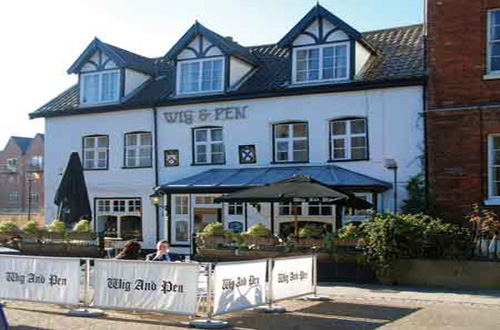
The licence to the White Lion (Palace Plain) can be traced back to the 18th century. It occupies a 17th century house which is reputed to have a tunnel from the cellar, now blocked up, which led to Whitefriars’ Bridge. In the 1985 Norwich’s new Magistrate Court opened down the road in Bishopgate. In the same year the pub was rechristened as the Wig & Pen. The name was adopted from the famous Wig and Pen Club on the Strand which served as a popular drinking den with both the journalists of nearby Fleet Street and lawyers from the Royal Courts of Justice opposite. Today the ‘Wig’ prides itself on the quality of its beers and food. It is especially popular in the summer months when customers spill onto the outside terrace overlooking the beautiful cathedral. Wild Man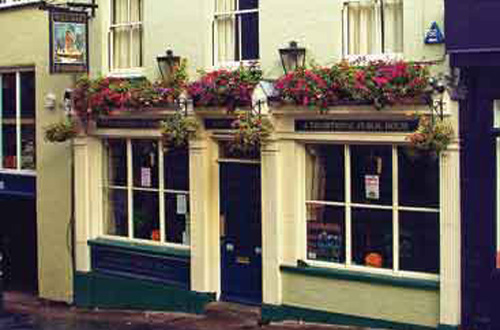
The name of the Wild Man (Bedford Street) is said to commemorate ‘Peter the Wild Boy’ The story goes that George I (1660 – 1727) had discovered Peter whilst hunting in a forest near Hameling, where he had been abandoned as a child. The king brought Peter back to England and left him in the care of Thomas Fenns of Berkhampstead from whence he escaped. He eventually made his way to Rackheath in Norwich, however, being unable to speak and dressed in rags he was assumed to be a vagrant and incarcerated in the Bridewell, a prison for minor offenders, tramps and beggars. In 1751, following a fire in the parish of St Andrew’s, Peter was transferred to the City Gaol (Guildhall) where he was recognised and returned to Thomas Fenns. He lived a further 34 years, not dying until the ripe old age of 73. The pub has been trading here since the 18th century. At one time it hade a special licence which allowed it to open at 4am for night shift workers. It is reported that by 8am a pianist would be well through their repertoire and it wasn’t unusual for whist drives to be well underway before breakfast. In 1974 the Wild Man had the distinction of being the only Norwich pub featured in the first CAMRA Good Beer Guide. The entry read: ‘Last Tolly house in Norwich serving beer by traditional methods.’ Woolpack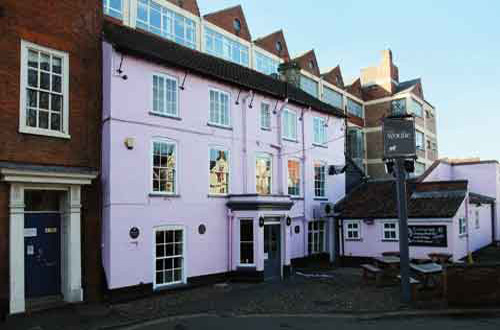
The licence of the Woolpack on Muspole Street can be traced back to the 18th century, though it may have been trading before then. Its name very much reflects that it is set in the midst of an area previously occupied by the old textile trade. The building it occupies was built in the 15th century and it is said that there was once a tunnel connecting it to the nearby St George Colegate church.
Woolpack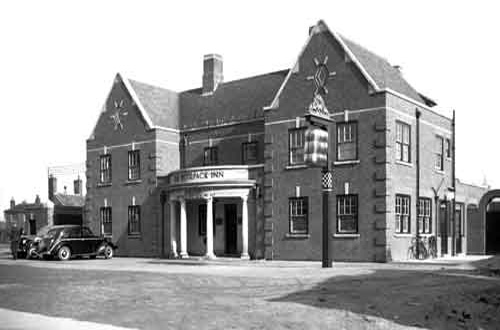
The licence of the Woolpack (Golden Ball Street) can be traced back to the late 18th century. It was originally located on Timber Hill but was rebuilt on its current site in 1938. At the time Morgans’ Brewery (who owned the premises) commissioned the artist Moray-Smith to produce six plaster bas relief panels depicting aspects of Norwich’s medieval wool trade, from which the pub gets is name.
The pubs heyday was in the late 1960s and 1970s when Douro Potter was landlord. Ray Lince, who began his licensed trade career working here with Douro explains why the Inn became so popular: ‘ Douro made sure that there were pretty girls behind the bar (always good for business) and brought in what were then thought to be very trendy ideas, like putting “ice and a slice” in the vodka and gin and serving wine as an alternative to beer and spirits. The wine was supplied by the Norwich Brewery, based in King Street, and was called “Tarafino”. This was, apparently a bit of an acquired taste and wouldn’t have suited today’s sophisticated wine quaffers. It wasn’t realised that white wine should be served chilled, and it was known at the Woolpack not as “Tarafino” but as “Parafino” ‘.
Adam & Eve, Bishopgate, Norwich

Many inns were called the Adam & Eve in the Middle Ages when the sign was the arms of the Fruiterers’ Company. It was common at this time for Eve to be depicted tempting Adam with an apple accompanied by a serpent coiled around the trunk of the ‘tree of knowledge’. In 1972 a new rather risqué sign was produced that excited so many complaints that the landlord had to return it to the brewery where the sign painters added two large, strategically placed fig leaves!
The Adam & Eve (Bishopgate Street) is believed to the oldest public house in the City still serving ales. Earliest references date back to 1249 when it was owned by the monks at the Great Hospital who used it as a brew house. At this time records indicate that it was frequented by labourers working on the cathedral who were paid with ‘bread and ale’. The original building was extended over the 14th and 15th centuries when living accommodation and the Flemmish gable ends were added.
It will come as no surprise that the Adam & Eve is supposedly haunted. The resident ghost is said to be Lord Sheffield who was killed in the vicinity during Kett’s Rebellion of 1549. However, in no way does he have exclusivity as it is also rumoured that sundry other ghosts often waft across from the nearby monks’ cemetery. If this weren’t enough the notorious 19th century killer James Rush was a regular at the Adam & Eve and is reputed to have plotted the murders of Isaac Jeremy, recorder of Norwich, and his son at the inn. Rush was captured and spent his last night in the dungeons of Norwich Castle before being hung in 1849.
Around the same time landlady Elizabeth Howes had an interesting sideline. She owned a wherry also called the Adam & Eve which she used to transport sand across from Yarmouth which she subsequently sold to local pubs for their floors and spittoons. On the face of it all was very respectable, however, hidden in the sand was contraband liquor which she successfully smuggled into Norwich for years! Artichoke
Artichoke, Magdalen Gates, Norwich

Many inns were called the Adam & Eve in the Middle Ages when the sign was the arms of the Fruiterers’ Company. It was common at this time for Eve to be depicted tempting Adam with an apple accompanied by a serpent coiled around the trunk of the ‘tree of knowledge’. In 1972 a new rather risqué sign was produced that excited so many complaints that the landlord had to return it to the brewery where the sign painters added two large, strategically placed fig leaves! The Adam & Eve (Bishopgate Street) is believed to the oldest public house in the City still serving ales. Earliest references date back to 1249 when it was owned by the monks at the Great Hospital who used it as a brew house. At this time records indicate that it was frequented by labourers working on the cathedral who were paid with ‘bread and ale’. The original building was extended over the 14th and 15th centuries when living accommodation and the Flemmish gable ends were added. Bell
Bell, Orford Hill, Norwich

The Bell on Orford Hill ( known as the Blue Bell from c1763 to c1822), was likely to have been in existence in the late 15th century. By the early 18th century it was an established hostelry and a renowned venue for cockfights. Thus it was in 1725 that the landlord advertised that ‘…there will be a great cock match at the Blue Bell…to show 31 cocks…Gentlemen shall be accommodated with a glass of excellent wine and care taken to prevent disturbance by the mob.’
In the 19th century the Bell continued to be linked with a variety of clubs and societies. In 1858 it hosted the first annual dinner of the Norfolk and Norwich Anglers Society. In October 1881 was the venue selected to celebrate the golden jubilee celebration of the Eldon Club, which also held meetings here. Club members included the Duke of Wellington.
Around 1890 parts of the Bell which fronted the present main road from Castle Meadow were pulled down. Luckily the main part of building survived.
Over the 20th century fortunes were mixed. During WW2 it played its part in the war effort when it was used as headquarters and billets for the American Women's Army Corps. Although it was closed twice in the second part of the century on 12th December 1993 the popular J.D.Wetherspoon group opened their first pub in the City here and it continues to thrive today. Birdcage
Birdcage, Pottergate, Norwich

In 1937 the traditional building occupied by the Morning Star on Pottergate was demolished and replaced by the contemporary building we see today. It did not meet universal approval and in 1945 was described in the City of Norwich Plan as being ‘incongruous in design and out of place in an ancient street’.
In the late 1980s it was briefly operated by Colin Keatley, now very well known for his success at the Fat Cat. As you would expect from Colin at this time it sold a range of real ales. When he took it on it was known as the Brown Derby but he renamed it the Pottergate Tavern and engaged Cass Hooton to design anew sign.
Today it is the home of the Birdcage, which it is fair to say would not describe itself as a traditional pub and is probably best summed up on its website which reports that it is open every day for ‘wines, wifi, work and play, coffee, cup cakes, cabaret and cocktails, board games, bloody marys and a bit of Bohemia.’
Since opening five years ago they have also operated as a music venue playing host to a wide variety of artists and showcasing many local independent musicians and artists. Cat & Fiddle
Cat & Fiddle, Magdalen Street, Norwich

Until it closed (c.2011) there had been a Cat & Fiddle on Magdalen Street from at least the 18th century. There are many Cat & Fiddle public houses in Britain, indeed records show that historically there have been four located in and around Norwich. But what is the origin of the somewhat unusual name? Some suggest it could derive from chat fidele which is French for faithful cat. Another possibility is that it derives form Catherine la Fidele, Catherine the Faithful, a nickname for Henry VIII’s first wife, Catherine of Aragon. However, one should perhaps just look at the sign, apply common sense and assume it is taken from the old nursery rhyme: ‘Hey diddle diddle, The cat and the fiddle.’ But herein lies another tale. Some suggest that ‘Hey diddle diddle’ offers a cryptic commentary on Richard III’s path to the English throne. Following the death of his brother Edward VI, Richard took over the position of regent on behalf of his young nephew, Edward V. He than placed the young king together with his younger brother in the Tower from whence they mysteriously disappeared. The finger of suspicion pointed at Richard III but his subjects were too frightened to voice their worries openly, hence they used nonsense verse. Here ‘Cat’ refers to Richard’s aide Sir William Catesby, of whom it was whispered had thought up the ‘fiddle’ that put Richard on the throne. Catherine Wheel>
Catherine Wheel, St Augustine's, Norwich

St Catherine, was one of the most popular saints in the Middle Ages. She lived in the 4th century and was daughter of the King of Cyprus. A number of legends are recorded as to why she was martyred at the hands of Emperor Maxentius, including both her refusal to marry him and to sacrifice to his gods. All do agree, however, that she was tortured and killed by being attached to a gigantic spiked wheel. Thus we have the birth of that most iconic of fireworks ‘The Catherine Wheel’. The Catherine Wheel was also adopted as the arms of the Knight of St Catherine of Mount Sinai an ancient order created for the protection of Mount Sinai. It is presumed that the Catherine Wheel, located at 61 St Augustines, along with many pubs of the same name adopted the name because of symbolic protection the knights offered to wayfarers.
The pub can trace its origins back to the 18th century. In 1790 it was in the news when it was reported “Dame Fortune has thrown £500 of the present lottery into the laps of thirty industrious individuals, who assemble as a club at the Catherine Wheel, St Augustine’s, in the city”.
Today the pub advertises itself as ‘Norwich’s favourite gay venue’ which prides itself on being friendly and fun. Here you can attend a variety of theme evenings including: quizzes, karaoke and cabaret. You can still view their 16th century well, a quirky fireplace (which following a revamp is now curiously located behind the bar) whilst from upstairs you can still view parts of the City Wall. Champion
Champion, Chapelfield Road, Norwich

The Champion (Chapelfield Road) was named after the boxer Daniel Mendoza (1764 – 1836) who was an English prizefighter. Before Mendoza, boxers generally stood still and merely swapped punches. Mendoza introduced a new ‘scientific style’ which incorporated defensive strategies to avoid punches. As a result Mendoza was able to overcome much heavier adversaries. Despite standing at only 5'7" and weighing 160 pounds, from 1792 to 1795 Mendoza was England’s Heavyweight Champion and is the only middleweight to ever win the Heavyweight Championship of the World. In 1789 he opened his own boxing academy and published the book: ‘The Art of Boxing’. After retiring from the prize ring he toured England’s theatres, which included a visit to Norwich, with an act which depicted the various ‘heroic styles of great boxers’
The pub, now owned by Batemans, is a traditional pub which offers its customers a wide selection of real ales. Coach & Horses
Coach & Horses, Bethel Street, Norwich

1710 is the date recorded on the wall of the Coach and Horses on Bethel Street, even so parts of the building are said to date back as far as 1200.
An old parish marker on the outside wall states that the inn lies between the parishes of St Peter Mancroft and St Giles and was the site of the once popular Ascension tide custom of ‘beating the bounds’ whereby choirboys were ‘bumped and dusked’ at their parish boundaries to ensure that they would not forget where the parish ended.
In 1987 it was swapped by Greene King for a Cambridge pub, and continues to be owned by them into the 21st century. Coach-
makers
Arms
Coachmakers Arms, St Stephen's Road, Norwich

The licence to the Coachmakers’ Arms can be traced back to 1802, though it may have been trading before this date. On the outside wall hangs Moray-Smith’s bas relief of St Stephen’s Gate, based on a 1792 Ninham print. Made c1937 it is said to weigh a little under a ton and be the heaviest ‘inn sign’ in Norwich. The panel was made and modelled on site. The artist is still remembered wearing jodhpurs and bright red stockings stood on scaffolding outside the pub putting the finishing touches to his work. The Coachmakers’ Arms continues to retain a small cobbled coach yard, which is now a sheltered seating area. Compleat Angler
Compleat Angler, Prince of Wales Road, Norwich

Seeing the opportunity to provide refreshments for travelers, on January 13th, 1851 Richard Bullard bought the Foundry Bridge toll house (Prince of Wales Road) from the Norwich Corporation for the princely sum of £430 and converted it into the Norfolk Railway House, sometimes called the Toll House.
The pub contained an annexe called the Blue Room. Built practically on the bridge you could walk through it onto the river walk. Through the years it has had many uses. In the 1930s it had a reputation for being used by working girls. Moving onto the 1950s there were still many American airmen stationed in Norfolk, however, some pubs refused entry to black Americans. Not so at the Blue Room. Despite the risk of losing the trade, black airmen were welcomed in and it became one of their main meeting spots in Norwich.
In 1973 it was closed for refurbishment, reopening in 1974 as the Compleat Angler in recognition of its proximity to the river. The ‘Compleat Angler’ in question is a book by Isaac Walton. First published in 1653 it is a celebration of the art and spirit of fishing.
The pub continues to be very popular today with its patio overlooking the river and of course its proximity to the railway station. Cottage
Cottage, Silver Road, Norwich

The licence can be traced back to 1830. Within ten years of opening it was the subject of some concern when it hosted meetings of a radical Chartist club inspired by John Love, Norwich’s first Chartist leader. Other public houses where gatherings took place included the Angel (Oak Street) and the Shuttle (St Augustine’s). Unsurprisingly all were located in the poorest areas of Norwich. For many years the Cottage was tied, however, it is now a freehouse and is able to offer its customers up to ten beers on hand pump from breweries across the country supplemented by a selection of continental draught beers and a wide selection of spirits. For music lovers the pub hosts weekly gigs performed by some of East Anglia's finest talent whilst regular quiz nights are held for those who want to put their general knowledge to the test. Delaneys St Andrews Brewhouse
St Andrew's Brewhouse, (previously Delaneys) St Andrew's Street, Norwich

On the August 1st, 1898 a fire broke out at Chamberlin’s department store which occupied a block fronting Guildhall Hill that stretched back along the length of Dove Street. Luckily the Edinburgh which was stood next door to the store appeared unaffected, then four days later just after the end of lunchtime trading the building collapsed. It was decided to transfer the licence, to premises on St George Street, which at the time was a grocer’s shop and open the Festival House. It took its name from the Norfolk and Norwich Triennial Music Festival which was first held at the nearby St Andrew’s Hall in 1824 and in its time played host to such great musicians as Edward Elgar and Vaughan Williams.
Until 1980 the corner bar was a Victorian gem complete with carved wood and mirrors. Unfortunately around this time it was ‘modernised’ and the bar was removed. Subsequently from 1992 to 2000 it was renamed several times, at one point being called the Grocer’s Ghost in memory of the buildings earlier use.
From 2001 to 2015 it operated as Delaneys, a very popular Irish theme pub. After which it was reinvented as St Andrew's Brewhouse, complete with a microbrewery and smoke house. Doghouse
Doghouse, St George's Street, Norwich

The building occupied by the Red Lion on St George’s Street is around 300 years old. An Elizabethan ordnance of a previous establishment states that the innkeeper was accused of harbouring ‘ill disposed persons and playing unlawful games with them day and night to the displeasure of Almighty God and to the evil example of others’.
In the 1950s and 1960s the Red Lion was part of the music scene and was one of the first Norwich pubs to feature a skiffle group, namely the Alley Cats.
In 1973 Courage brewery undertook a £27,000 conversion during which an impressive inglenook fireplace was uncovered.
For many years the Red Lion was the nearest pub to the Norwich School of Art, now transformed into the Norwich University College of the Arts, and was a favoured meeting place for staff and students, both past and present.
The Red Lion closed c2005 and following a further conversion it reopened as the Doghouse Bar. Edith Cavell
Edith Cavell, Tombland, Norwich

The Tombland Stores (Tombland) originally opened as a beerhouse in 1870. In the early 20th century it was briefly converted into a clothing shop. When it opened again as a tavern it was rechristened as the Army & Navy stores after a home for soldiers and sailors on Queen Street. In 1975 it was described by John Riddington Young as being: ‘A tourist attraction in the summer for those foreigners who wanted to see “an English pub”. The etched windows indicate where the original rooms used to be. The best example faces the cathedral and bears the endearing epithet “Jug and Bottle”. The back of the bar is a fine example of Victorian pub décor.’ In 1994 it was rechristened after local WWI heroine Edith Cavell, who is buried in the nearby Cathedral Close. Escape
Escape European Bar, Magdalen Street, Norwich

A pub has been trading on the same site at, 102 Magdalen Street, since the 1830s. Around 1950 it became the property of Messrs Backs, when it was one of their famed freehouses. During this time a huge barrel was hung outside as a sign that Backs kept their cellars fully stocked. This led to the house being known locally as the ‘Tub’. Other public houses in the Backs empire included the Curat’s House and the Vine Tavern. In the early 21st century it traded as “The Escape European Bar”, before being reinvented as the Cactus Cafe Bar. Fat Cat
Fat Cat, West End Street, Norwich

The Fat Cat is one of Norwich’s most successful pubs of modern times. As we write it has twice been named the CAMRA National Pub of the Year whilst the Good Pub Guide has awarded it the title of Beer Pub of the Year, no fewer than four times. So although it is located outside the 1884/5 City-centre map, we decided that it had to be included.
Going back to 1868 the hostelry was owned by Steward & Patteson and it traded as the New Inn. During 1972, whilst owned by Watneys, it was one of 42 pubs in the City swapped with Courage as part of a government-enforced scheme aimed at bringing more competition to the market. In 1991, when it was bought by Colin and Marjory Keatley, it was sold by Courage as a failing ‘bottom end’ pub. Following his tenure at other City hostelries, including the White Lion (Oak Street), Colin was already building up a reputation for selling real ales. When he bought the New Inn he was particularly inspired by the ethos of the Fat Cat pub in Sheffield and decided to rechristen the New Inn accordingly. Subsequently it was closed for five months during which time the premises were refurbished. It reopened with a new décor and, more importantly, four hand pumps. Today the décor remains simple. On the walls is a superb selection of pub memorabilia, including wonderful old pub signs, indeed its worth visiting just to see these. The Fat Cat is one of the few, successful hostelries which doesn’t sell cooked food instead clientele are offered an extensive range of beverages including real ales from no fewer than 12 hand pumps. Amongst the ales on sale are those produced by the Fat Cat Brewery on Lawson Road (Norwich) which was opened in 2005. Located behind the Brewery Tap (previously the Shed) its opening was the realisation of Colin’s dream to operate a brewery. Its brews have included: Marmalade, Cougar and Cat & Canary (the latter in support of Norwich City Football Club aka The Canaries). Freemason Arms
Freemason's Arms, Hall Road, Norwich

The original Freemasons’ Arms (Hall Road) was a much smaller alehouse than the pub which still trades today. It expanded when the brewery took over the adjacent post office. From 1885 to 1912 the landlord was well known local sportsman George Rye. In his day George was one of Norfolk County Cricket Club’s best medium-paced bowlers. He subsequently refereed many a match at the Lakenham ground after which he just about managed to sprint back to the pub and be ready for the crowd who would call in to discuss the match over again. During George’s reign the pub naturally became very popular with many local sportsmen including cricketer ‘Bones’ Howlett and boxer ‘Cock’ Blyth. Between 1994 and 2005 the premises were taken over by Woodforde’s Brewery who asked for suggestions for a new name and couldn’t resist calling it after Norwich character Billy Bluelight (c1860 – 1949) who was renowned for standing outside pubs and factories extolling the virtues of abstention. When Woodforde’s sold the pub the name reverted back to the Freemason’s Arms, and Billy could rest easily again. Gardeners' Arms (Murderers)
Gardeners' Arms, better know as the 'Murderers', Timberhill, Norwich

The licence of the Gardeners Arms on Timber Hill can be traced back to 1841 but the building itself dates back to 1696. It has a fascinating history. Since the early 20th century it has been better known as the Murderer’s Arms. For many years it was believed that it received its somewhat sinister nickname after a prostitute who frequented the tavern was murdered by a client.
In 1970 the pub was closed by Watneys and for a time it was used for a charity shop. Then in 1976 it was reported that Douro Potter the ‘uncrowned king of the city centre pub trade’, working with partner Ray Lince, was about to spend £20,000 on renovating the premises. At the time they wanted to officially change the name to the Murderer’s Arms, however, tentative enquiries at City Hall were not encouraging. Undeterred Ray arranged for the ‘Muderer’ to be depicted on the one side of the pub sign and the ‘Gardeners’ on the other, an arrangement which carries on today.
The pub continues to be very popular in fact in 2009 it was listed in the Lonely Planet travel guide as a ‘must visit’ attraction which since taking over an adjacent property now also incorporates the Murderers’ Café Bar. Glass House
Glass House, Wensum Street, Norwich

In 2001 the Glasshouse (Wensum Street) was the third J.D. Wetherspoon pub to open in the City centre. As its name suggests it is partly housed in the premises of a former glass merchant. The premises is light and airy and with an attractive outside seating area. The chain was founded in 1979 when the 24 year old law graduate Tim Martin opened his first pub in Colney Hatch Lane, London. Wetherspoon’s champions cask ale, low prices, long opening hours, and no music It is said that Tim named his business after a tutor, a Mr Wetherspoon, who had written on his report card: ‘Tim will probably amount to nothing.’ The initials ‘J.D.’ were added in honour of Tim’s favourite television character of the 1970s, J.D. Hogg from the Dukes of Hazard. Golden Star
Golden Star, Colegate, Norwich

The licence of the Golden Star on Duke Street can be traced back to the 1860s. In 1970 It was closed by Watney Mann and it seemed that the building was likely to be demolished. Then in 1975 Peter Turner negotiated the lease from the City Council and he, together with his wife Carol, got to work. This is their story:
‘When we moved in during 1976 it was derelict and inside was positively grim. We had to do a lot of work before we opened which included knocking down walls and a total refurbishment. We didn’t have carpets but wanted to create a traditional drinkers pub with bare floorboards, wooden panelling and wooden seats. We even had a mulling iron which stood by the open fire in the back bar for those wanting to drink mulled ale.
In 1984 when Carol and Peter sold the Golden Star to Greene King the Evening News reported that ‘there was genuine sadness at the demise of the pub which had been a last bastion of resistance to juke boxes, video games and fruit machines…It was the end of an era’. On their final night at the pub a wake was held which spilled onto the streets outside. Performers who had met at the pub including the Golden Star Morris entertained the crowds.
Two hundred customers, who feared that Greene King would alter the Star’s interior and ruin its unique character, signed a petition. The new owners listened, retained the old Star spirit and opened to ecstatic review and it continues to trade today Hog in Armour
Hog in Armour, Charing Cross, Norwich

In 1891 the Three Pigeons, which was located on the corner of St Benedict’s and Westwick Street, was destroyed to allow the road to be improved. The licence was transferred to 16, Charing Cross were the pub continued to operate. In 1977 its name was changed to the Hog in Armour which it still trades under today.
The term ‘hog in armour’ appears to date from the 18th century and seems to be a variation on the phrase that you can’t make a silk purse out of a sow’s ear. The original sign was painted by Peter Burrows and very much reflects the view of the Baptist preacher Charles Spurgeon (1834 – 92) who said : ‘A hog in a silk waistcoat is still a hog.’ Kings Arms
Kings Arms, Hall Road, Norwich

The King's Arms was built in 1824 and first licensed 1830. Around 1855 Thomas Cott, a pawnbroker, sold it to local brewers Charles Crawshay and John Youngs for £545.
From 1951 to 1973 the pub was presided over by popular landlord Charlie Drake who became so well known the pub was just referred to as ‘Charlie Drake’s’. After being a tied house for a number of years in 1998 it was purchased by John Craft and Nicky Howard who ran it as a freehouse selling a wide range of well kept cask ales.
In 2004 it was bought by Batemans’ Brewery of Wainfleet who carried on John and Nicky’s good work. In fact the King's Arms has gone from strength to strength and has the accolade of being listed in all CAMRA Good Beer Guides this century!
The King's Arms is a traditional city pub that takes pride in offering a great selection of: real ales, imported draught lagers, cider and a range of bottled Belgian beers together with a wide selection of wines and spirits. It considers itself a ‘proper local’ and is well set up having both a beer garden and conservatory. It is a favourite with Norwich City fans before and after games but always welcomes away fans, as long as they appreciate real ale! Although food is available at lunchtimes in the evenings customers are encouraged to order food in from one of the many local take-aways. The landlord than supplies: plates, cutlery, napkins and condiments enabling diners to enjoy their meals in comfort. Kings Head
Kings Head, Magdalen Street, Norwich

The licence of this pub, located at 42 Magdalen Street, can be traced back to 1760 and remarkably 300 years later it is still trading. Despite an extensive renovation 2004/5 the entrance to the adjacent court still depicts the emblem of the Crown Brewery, dating back to when it was tied to Youngs, Crawshay & Youngs. Also you can see the gargoyles with their crown clearly depicting a ‘king’s head’ between the windows. The image on the sign seems to be based on King Richard II. Adjacent to the pub is an excellent example of an old Norwich Yard. The building has recently been restored but still retains a traditional feel. As would be expected from an establishment which has been given the award ‘CAMRA Pub of the Year’ it boasts an impressive selection of real ales which are served in a welcoming friendly atmosphere. On top of all this the King’s Head is one of the few pubs in the area with its own bar billiards table and even hosts a league. Lamb
Lamb, Orford Place, Norwich

Following the Norman invasion in 1066 a Jewish Ghetto was established in the area between the Haymarket and White Lion Street. In 1296, four years before Edward I expelled all Jews from England, it was ravaged by fire. Subsequently part of the area, including that now occupied by the Lamb (Old Haymarket), was settled on the Church of the Mass of Jesus, in nearby St Peter’s. When an inn was established it was given the suitably ecclesiastical name of the ‘Holy Lamb’ later abridged to the ‘Lamb’.
More recently in 1979 the premises was renovated. It was decided that spreading sawdust on the floor would create an authentic and convivial atmosphere, a view not shared by the health and fire authorities who condemned the building as a fire hazard. It subsequently reopened with a brand new carpet! Then in 1996 there was much consternation in the City when the ancient house was renamed the Rat & Parrot eventually becoming ‘Henry’s Cafe Bar @The Lamb Inn’. 2011 saw this historic inn given a traditional décor ‘with a modern twist’ and rechristened as the Lamb, although to be fair, locals have never called it anything else! Lawyer
Lawyer, Wensum Street, Norwich

In the late 18th century a Joseph Geldart occupied these premises on Wensum Street where he operated as a wholesale and retail dealer in ‘wine, brandy, rum and other sprits’. In the early 19th century the premises was licensed as the Grapes. Between 1911 and 1972 it was part of the local chain established by P.G. Back. Subsequently it underwent many name changes. It has recently been attractively refurbished and renamed as the Lawyer and prides itself on offering ‘… real ales, premium lagers, a huge wine selection and fantastic authentic Thai food.’ Leopard
Leopard Bull Close Norwich

The Leopard, on Bull Close Road, can trace its licence back to the early 19th century. Normally when an animal appears on a pub sign it is of heraldic origin and design which is why we have so many White Horses and Red Lions. It is rare that a non heraldic, aggressive animal gives its name to a pub yet in this vicinity we once had both the Leopard and the Tiger. No one is quite sure why although it isn’t beyond the realms of possibility that the signs were once very badly painted lions, alternatively it could be explained by the cavalry telling of their exploits whilst defending the Empire.
From c.2007 the premises was owned by Batemans who sold it in 2013 after which it operated as a freehouse. Macawber's Tavern
Macawber's Tavern, Pottergate, Norwich

The Alma on Pottergate was built in 1772. It was originally called the Duke of York but was renamed the Alma c1856 to commemorate Lord Raglan’s victory over the Russians in 1854, in what was the first key battle of the Crimean War.
John Riddington Young recalls the autumn of 1971 when a party was held to mark the closure of the pub. The dartboard and ashtrays were given away and festivities extended well beyond closing time. The following morning the Brewery paid a visit to the licensees, Jessie and Billy, to tell them there had been a mistake and it wasn’t to close at all. So the dartboard was returned and another party was held to celebrate the reopening!
It did, however, finally closed c1975 before being reopened as Micawber’s Tavern in 1977 a name which , despite a brief period as Seamus O’Rourke’s, it still holds today. Marquee
Marquee, Cattle Market Hill, Norwich

Being close to the Cattle Market the Shirehall Tavern (Cattle Market Street) was very popular with farmers and dealers who could use the large yard at the rear to store pigs and cattle. It is also reputed to have once provided lodgings for judges sitting at the nearby Shirehall, the building which gave the establishment its name.
Historically the Shirehall was the centre for jurisdiction and administration for the county. As early as 1270 a Shirehouse was located next to the Castle and was subsequently rebuilt in 1579 on the castle mound. In 1821 it was relocated to the base of the mound, where it stands today. It is still linked to the Castle by a tunnel which was originally used to take prisoners between the courts and the prison (which was locatedin the Castle). In 1988 the courts moved to a new site by the Cathedral and the building now houses the Regimental Museum and Norwich Castle Study Centre.
In the latter part of the 20th century the pub has enjoyed mixed fortunes and a number of name changes. In the early 21st-centry it was christened as the Marquee, when it developed as a popular entertainment venue featuring comedy and live music. It subsequently changed its name to the Owl Sanctuary, the name deriving from the comedy show 'I'm Alan Partridge'. It has since closed. Mischief Tavern
Mischief Tavern, Fye Bridge Street, Norwich

The Wine Vaults on Fye Bridge Street was housed in 16th century merchant’s house. From the 1890s it traded as Carter Steward and co Wine Vaults than in 1963 was rechristened the Mischief, a name it still holds today. At one time a copy of Crome’s version of Hogarth’s sign of the ‘Man Loaded with Mischief’ hung here. The sign depicted a man with a careworn face. A chain labelled ‘wedlock’ hung around his neck and bound him to his wife whom he carried on his back. She in turn drank a glass of gin whilst supporting a monkey and a magpie, symbols of mischief and strife. In today’s politically correct world the pub sign is much more acceptable depicting as it does a mischievous little boy.
In 1964 local jazz legend Albert Cooper, together with his brother Tony, launched a new folk club at the Mischief: ‘It was my brother Tony’s idea to start the Jacquard club. Folk music was becoming prevalent and he already had experience as he ran a trad jazz club called “Jazz at Studio 4” based at the back of Anglia TV. We looked around for a room and eventually found one at the back of the Mischief Tavern. It used to be the pub brewery and had a sloping floor and a gutter running through the middle. The landlord Leslie Izzard and his wife Billie agreed to let us use it every Thursday.We wanted a folk oriented name with a bit of history to it. We came up with the Jacquard club after Joseph Marie Jacquard who invented the first automated loom which was used to make Norwich Shawls. ‘You could fit in eighty people at a squeeze. Mind you it was than so packed you couldn’t move. Performers included Judy Collins and Paul Simon. They didn’t want much, I suppose we paid them about £15 in those days, which was a fair bit but not a fortune. I performed as “Albert and the Jacquards” backed by Gerry Parish and Dave Keeley. No 12
No 12, Market Avenue, Norwich

The Plough (Market Avenue), sometimes called the Plough & Horses, would have received its name because of its proximity to the Cattle Market.
After being bombed in 1943 it was closed as a public housed but was used by the American Army as headquarters for the Military Police. In 1973 it was taken over by Douro Potter and renamed La Rouen. After trading for over 150 years it was temporarily closed c1995 after it was disovered that the Castle Mall development had undermined the building.
Today it trades as the Number 12 bar and restaurant where customers can relax in rooms full of charm and character. Plasterers Arms
Plasterer' Arms, Cowgate, Norwich

This is one of the many taverns in the City which bore the name of some trade or occupation. Typically the name would be given to an establishment where workers met either socially or to discuss the business of their guild. Often, as happened here, the tavern would take on the name of ‘Arms’ which would then be depicted on the pub sign. Interestingly the Brickmakers and Plasterers, both from the building trade, appear to have been based within 200 yards of each other. The pub sign still depicts the actual Arms’ of the Plasterers with its motto of: ‘ Let brotherly love continue.’ The central shield contains images of a trowel between two plasterers’ hammers whilst below the chevron we see a plasterers’ bush. The licence of the pub, which still trades in 2011, can be traced back to the early 19th century. In the mid 1970s it became a real ale hot spot when in 1976 it was bought by Derek Howard, who also owned the Ten Bells on St Benedict’s, for £12,600. Pete Turner, later landlord at the Golden Star, remembers it well: ‘ At the time it was virtually impossible to get draft beers. You could get Adnams at the Maids Head and Worthington E at the Wild Man, and that was about it. I think that these were the only free houses in Norwich. We sold Tolly Cobbold, Adnams, Greene King, IPA and Abbott. Customers used to walk through the door of the Plasterers and see the six hand pumps, fall on their knees and bow down in front of them. It was real ale Nirvana. The crowd at the bar was regularly six deep it was a real scum. When we cleaned in the morning we’d find £5 and £10 notes in the rubbish on the floor.’ Plough
Plough, St Benedict's Street, Norwich

The Plough (St Benedict’s Street) is located in a 17th-century merchant’s house. The pub gave its name to both Plough Yard and Little Plough Yard, which it stands between.
A plasterwork plough in a distinct ‘Wedgwood’ style is highlighted on the front wall. The sign was popular in agricultural areas and Norwich’s other Plough, which stood near to the Cattle Market on Farmers’ Avenue, had this connection. The plough was also the main heraldic device on the Crawshay family’s coat of arms.
In 2009 the Plough was closed and subsequently bought by the Grain Brewery, a small venture located in the Waveney Valley. Following an extensive renovation it was reopened in April 2010 to rapturous reviews. Particularly popular is the beautiful beer garden, a rare commodity in Norwich. Prince of Wales
Prince of Wales, Prince of Wales Road, Norwich

The Prince of Wales (Prince of Wales Road) has operated from here since the late 19th century. Despite being damaged during raids in April 1942 it still trades from the same site today where it is now located adjacent to some of Norwich most popular nightclub venues. Red Lion
Red Lion, Bishopgate, Norwich

The Red Lion along with the Adam & Eve (both located on Bishopgate Street) were once owned by the monks who resided at the nearby Great Hospital. Parts of the building it still trades from today can be traced right back to the 16th century. In the 1970s it was renowned for its musical evenings and it is said to have been the venue where the Mutton Chop Banjo Band was launched! Ribs of Beef
Ribs of Beef, Wensum Street, Norwich

The Ribs of Beef is one of Norwich’s most popular City Centre pubs. As early as 1743 it was operating as a licensed premised. In 1898 the front half of the building was demolished as part of a road widening scheme to allow electric tramway tracks to be laid, nevertheless the remaining building was rescued and the pub reopened in 1904. In 1929 it was renamed the Fye Bridge Tavern in anticipation of the new twin span bridge which was built to alleviate the River Wensum flooding the city as it had in 1912.Then in 1958 the pub was delicensed. Over the following years the building housed an antique shop, an electrical shop and a ladies fashion boutique before Roger and Anthea Cawdron relicensed it in 1985 as the Ribs of Beef. Most real ale pubs at the time had floorboards and benches but the thick carpet and leather seats appealed to the locals and professional clientele who required more comfort. Serving a range of cask ales from all over the UK and excellent food and wines it quickly established itself as ‘the City's favourite local’. Rose Tavern
Rose Tavern Queen's Road Norwich

The Rose (Queen’s Road) was first licensed in the mid 19th century. Since then it has been known as the Rose Tavern, the White Rose and today simply as th Rose. It's proximity to Carrow Road means it is particularly popular on match days.
Rumsey Wells
Rumsey Wells, Charing Cross,Norwich

The licence to the Shrub House, originally located at 2, St Andrew’s Street, can be traced back to 1842. Originally it was the premises of Ward & Seaman who traded in wines and spirits. In 1974 the premises was extended to incorporate 4, St Andrew’s Street which had been Wells & Son hat shop.
In 1979 the Shrub house closed and the original corner bar (2, St Andrew’s Street) became a newsagents. Around 1984 the remaining property was reopened as Blueberries. It has since traded as both the St Andrew’s Tavern and the Rumsey Wells. Today it trades under the latter name and prides itself on providing premium booze, including a good selection real ales and foreign beer, pub grub that ‘resembles good British home cooked food’ and regular live music. Steam Packet
Steam Packet, Crown Road, Norwich

There were three Steam Packets open within the City centre in 1884. The definition of a steam packet is ‘a ship that sails a regular route between two ports’. In the late 1800s such a steam ship travelled from Norwich to Bramerton Woods End, Coldham Hall and other riverside resorts. The Steam Packet on Crown Road has undergone many name changes since it opened c1840. Not surprisingly, in view of its vicinity to the Cattle Market, for most of the 20th century it was called the Market Tavern. It was here that farmers would have come to make many transactions. However, in 1993 it was once again christened the Steam Packet Tavern, a name it retained into the 21st century. Sir Garnet
Sir Garnet, Market Place, Norwich

The Sir Garnet (Market Place) started trading as a public house c1861. It was originally called the Baron of Beef, possibly because the premises used to be a butcher’s shop. In 1874 the house was renamed the Sir Garnet Wolseley, at which time a new Baron of Beef opened in premises standing on the corner of Gentleman’s Walk and the Market Place.
It was named after Field Marshal Garnet Joseph Wolseley, 1st Viscount Wolseley who, in the same year the name was adopted, had received accolades for his brilliantly executed Ashanti campaign. The Field Marshal’s reputation for efficiency led to the late 19th century English phrase ‘everything’s all Sir Garnet’, meaning ‘all is in order’.
In the 20th century the pub extended in size when it took over 37, Market Place, which had previously traded as the Punch Bowl. Today, as it has been throughout its long history, it is easily recognisable by its distinctive curved balconies which overlook the Market Place. Surrey Tavern
Surrey Tavern, Surrey Street, Norwich

The Surrey Tavern took its name from the street it stands on. In turn, Surrey Street was thus named in Tudor times, when the Earl of Surrey lived there. His mansion has long since disappeared. It was replaced in 1905 by the opulent Surrey House, designed by George Skipper as the new headquarters of the Norwich Union Life Insurance Society, now Aviva. For many years the hostelry was very popular with Aviva staff whose offices are located nearby. It has since reinvented itself as a cafe bar. Temple Bar
Temple Bar, Chapelfield, Norwich

The Tuns (Unthank Road), now rechristened the Temple Bar, survived when many of its immediate neighbours were demolished to make for the new inner ring road. It used to be thought that the house was as old as the Adam & Eve (Bishopgate), however, this listed building is now known to date back only to the 17th century. Its age has been ‘disguised’ by a 19th century façade.
In the 1860s, when election fever ran high, the Tuns espoused the cause of the ‘Orange and Purples’ (the Tories) whilst the nearby Grapes Hotel (Earlham Road) was a ‘Blue and White’ (the Whigs) stronghold. During the elections each house would put a placard announcing the ‘state of the poll’ on an hourly basis which led to many lively altercations on the plain separating the two establishments.
From 1892 to 1911 the Tuns was presided over by landlord ‘Bob’ Booty, who as a sideline drove the Judges’ carriage. Booty built a reputation for putting on convivial evenings remembered nostalgically by Walter Wicks who recalls him serving ‘tradesmen’s suppers of rabbit and neat’s cheek, sumptuously served, invariably followed by an excellent smoking concert, when some of the best amateur talent in the county contributed to the harmony of the evening.’ Ten Bells
Ten Bells, St Benedict's Street, Norwich

There has been much speculation as to the origin of the Ten Bells name. It has been trading here since at least the 18th century and is thought to allude to the fact that at one time you could stand on this stretch of street and clearly hear the bells from ten different churches. Today it is tied to Greene King, however, in the mid 1970s it was a free house and one of the few places in Norwich that you could buy real ale. Trafford Arms
Trafford Arms, Grove Road, Norwich

The Nursery Tavern can be traced back to 1865. It is possible that the first landlord, Robert Allen, continued his horticultural activities as well as being a publican, hence the name. In 1886 the Nursery Tavern was demolished and the licence was transferred across to a new building that was erected on what is today 61 Grove Road. The new premises, renamed the Trafford Arms, continues to trade on the same site today - depite a number of setbacks.
In March 1895 disaster struck the Trafford Arms when a three hour cyclone blew two large chimney stacks through the roof of the pub. It was repaired than on 27th May 1942 it was severely damaged by bombing. As a result on 15th October 1942 the licence was suspended because of ‘war circumstances’. There was some concern that if the pub did not reopen within a short time scale that the licence may be forfeited. As such between August 1943 and 17th November 1955 the Trafford was run by the landlord and his wife, Cecil and Doris Clarke, in a temporary wooden building converted from a large broiler house, known as the ‘Chicken House’. In autumn 1955 the first half of the present building was completed. The pub closed one evening in the Chicken House and reopened the next morning in the new wing (no pun intended) which later became the bar.
Trowel & Hammer
Trowel & Hammer, St Stephen's Road, Norwich

Around 1700 the tavern was known as the ‘Spittle House’, believed to be a corruption of the word hospital, as it is documented that it was frequented by ‘lepers, lame and decrepit persons’. By 1755 it was known as the ‘Lazar House’, ‘lazer’ being an old term for leper. By 1811 it was operating as a tavern. It is assumed that the name relates to a trade guild, however, it is also possible that an early landlord was a freemason. In 1829 the artist William Martin (1753 to 1831) was lodging here in very poor circumstances. Martin had painted two large pictures namely ‘The Death of Lady Jane Grey’ and ‘Queen Eleanor, Consort to Edward I’, both of which hung for some time in St Andrew’s Hall. Around the same time he was voted a grant of 100 guineas by a sympathetic Norwich Corporation.
Although for five years from 1997 it was transformed into Finnegans Wake, an Irish theme pub, this friendly tavern still trades today as the Trowel & Hammer. Vine
Vine, Dove Street, Norwich

The Vine (Dove Street) is possibly best described as ‘small but perfectly formed’, but this has not always been the case.
The licence can be traced by to 1842, however, it closed in 2006 and the end seemed nigh, however, in 2008 it was rescued and reinvented. Today, despite being hailed as Norwich’s smallest pub, the owners have managed to integrate a pub with a Thai retaurant. This has been achieved by combining two miniscule rooms downstairs into an area containing four small tables and a mini bar whilst the dining room is upstairs. Even more remarkable, given the limited space, in 2011 the Vine made its way into the Good Beer Guide. Walnut Tree Shades
Walnut Tree Shades, Post Office Court, Norwich

The licence of the Walnut Tree Shades (Old Post Office Court) can be traced back to 1841.
John Riddington Young speculates that although this would be a name/ sign frequently adopted by cabinet makers, there is no evidence that this was the case here. In the past the premises were used by the Norwich Brewery as an outlet for trial brews and apparently Starlight was first sampled here!
For many years the premises successfully traded as an American bar and diner. It has recently been sold, renovated and decorated and is now offering its clientele live bands, good food and a selection of ales. White Lion
White Lion, Oak Street, Norwich

Parts of the building which house the White Lion (Oak Street)can be traced back to the late 16th century. In 1884 it was one of the many pubs trading along Oak Street, today it is the only one still trading. In April 1942 Oak Street was badly hit during the Baedeker Raids. Although the White Lion survived the old Empire Picture House was badly damaged and all the little yards leading from Oak street were hit including : Little Buck Yard, Royal Oak Yard, Old Brew Yard and Angel Yard. It survived again when the Courtaulds factory, its immediate neighbour, was burnt out.
In 1980 Colin Keatley (who now owns the Fat Cat pub and brewery) bought the White Lion and turned it into a real ale house. At the time it was one of only a handful of pubs selling real ale in the City. It coincided with Ray Ashworth opening Woodforde’s brewery on an industrial estate at Drayton and within a year of Woodforde’s making their first brew Colin started to sell their beers which has done non stop in his various establishments giving him the accolade of ‘Woodforde’s longest standing customer’.
Colin sold the White Lion in 1988. In the following years its fortunes varied, however, in 2008 it was bought by the Milton Brewery, based in Cambridge. It serves a range of Milton beers together with guest brews from across East Anglia. Customers are welcome to play bar billiards and darts or take part in regular quiz nights. Wig &
Pen
Wig & Pen, Palace Plain, Norwich

The licence to the White Lion (Palace Plain) can be traced back to the 18th century. It occupies a 17th century house which is reputed to have a tunnel from the cellar, now blocked up, which led to Whitefriars’ Bridge. In the 1985 Norwich’s new Magistrate Court opened down the road in Bishopgate. In the same year the pub was rechristened as the Wig & Pen. The name was adopted from the famous Wig and Pen Club on the Strand which served as a popular drinking den with both the journalists of nearby Fleet Street and lawyers from the Royal Courts of Justice opposite. Today the ‘Wig’ prides itself on the quality of its beers and food. It is especially popular in the summer months when customers spill onto the outside terrace overlooking the beautiful cathedral. Wild Man
Wild Man, Bedford Stree,t Norwich

The name of the Wild Man (Bedford Street) is said to commemorate ‘Peter the Wild Boy’ The story goes that George I (1660 – 1727) had discovered Peter whilst hunting in a forest near Hameling, where he had been abandoned as a child. The king brought Peter back to England and left him in the care of Thomas Fenns of Berkhampstead from whence he escaped. He eventually made his way to Rackheath in Norwich, however, being unable to speak and dressed in rags he was assumed to be a vagrant and incarcerated in the Bridewell, a prison for minor offenders, tramps and beggars. In 1751, following a fire in the parish of St Andrew’s, Peter was transferred to the City Gaol (Guildhall) where he was recognised and returned to Thomas Fenns. He lived a further 34 years, not dying until the ripe old age of 73. The pub has been trading here since the 18th century. At one time it hade a special licence which allowed it to open at 4am for night shift workers. It is reported that by 8am a pianist would be well through their repertoire and it wasn’t unusual for whist drives to be well underway before breakfast. In 1974 the Wild Man had the distinction of being the only Norwich pub featured in the first CAMRA Good Beer Guide. The entry read: ‘Last Tolly house in Norwich serving beer by traditional methods.’ Woolpack
Woolpack, Muspole Street, Norwich

The licence of the Woolpack on Muspole Street can be traced back to the 18th century, though it may have been trading before then. Its name very much reflects that it is set in the midst of an area previously occupied by the old textile trade. The building it occupies was built in the 15th century and it is said that there was once a tunnel connecting it to the nearby St George Colegate church.
Woolpack
Woolpack, Golden Ball, Street, Norwich

The licence of the Woolpack (Golden Ball Street) can be traced back to the late 18th century. It was originally located on Timber Hill but was rebuilt on its current site in 1938. At the time Morgans’ Brewery (who owned the premises) commissioned the artist Moray-Smith to produce six plaster bas relief panels depicting aspects of Norwich’s medieval wool trade, from which the pub gets is name.
The pubs heyday was in the late 1960s and 1970s when Douro Potter was landlord. Ray Lince, who began his licensed trade career working here with Douro explains why the Inn became so popular: ‘ Douro made sure that there were pretty girls behind the bar (always good for business) and brought in what were then thought to be very trendy ideas, like putting “ice and a slice” in the vodka and gin and serving wine as an alternative to beer and spirits. The wine was supplied by the Norwich Brewery, based in King Street, and was called “Tarafino”. This was, apparently a bit of an acquired taste and wouldn’t have suited today’s sophisticated wine quaffers. It wasn’t realised that white wine should be served chilled, and it was known at the Woolpack not as “Tarafino” but as “Parafino” ‘.
Although Norwich can no longer boast that it 'has a pub for every day of the year' it still retains a diverse mix of hostelries which are the envy of other cities.
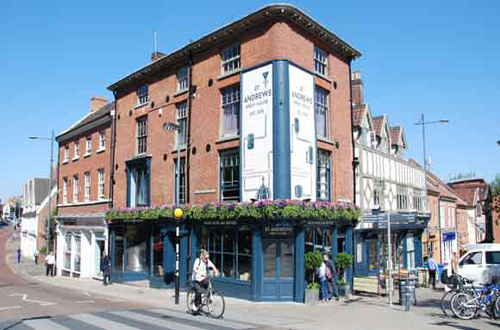
In this section we do not attempt to give a critique of the pubs and their beers, a task which we leave to the experts at CAMRA, but to merely give a flavour of the fascinating histories of a selection of hostelries which survived into the 21st century.

